HON HAI PRECISION IND T77W595 LTE Cat4 PCI Express M.2 Module User Manual rev
HON HAI Precision Ind. Co., Ltd. LTE Cat4 PCI Express M.2 Module rev
User Manual_rev.pdf
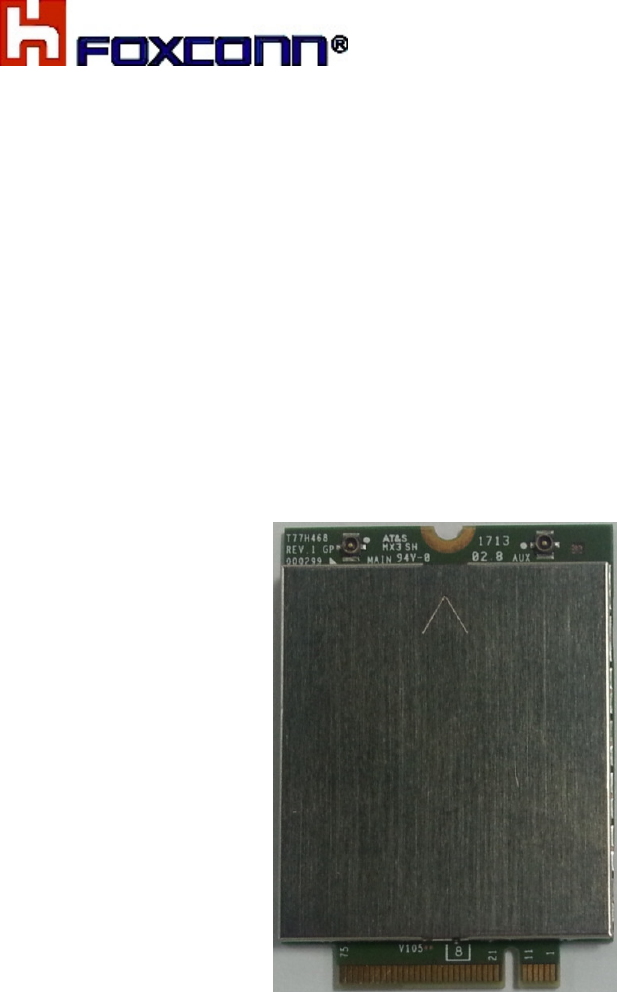
COMPANY CONFIDENTIAL
- 1 -
3GPP Long Term Evolution Cat4
PCI Express M.2 Module
Engineering Requirements Specification
Project code: T77W595.00
Solution: MDM9625+WTR1625L
SKU: WW-1-S3
Copyright © 2014. Foxconn Communications Inc. All rights reserved.

COMPANY CONFIDENTIAL
- 2 -
Reviewers
Department Name Signature Review Dates
* Plan
** Results
Project Manager Choro.Chung
Project Leader Ai-ning Song
Hardware Engineer Shao-you Lin
Modification History
Rev
Date Originator Comment
D0.1 2014/07/26 Ai-ning Initial release for carrier engagement
, will update it after
fix hardware design
D0.2 2014/09/11 Henry Tang
Add SW section of “USB Enumeration” and “Windows
Morphing”

COMPANY CONFIDENTIAL
- 3 -
CONTENTS
1.
GENERAL DESCRIPTION ...................................................................... 4
1.1
SYSTEM MAIN FEATURE ...................................................................... 5
1.2
SYSTEM BLOCK DIAGRAM .................................................................. 9
1.3
PIN DEFINITION ..................................................................................... 10
1.4
PLATFORM CONNECTION DESIGN ................................................. 14
2.
HARDWARE FEATURES ..................................................................... 22
2.1 MOBILE DATA MODEM ............................................................................... 22
2.2 RF TRANSCEIVER ........................................................................................ 23
2.3 POWER MANAGEMENT IC ........................................................................ 23
2.4 ANTENNA DESIGN ....................................................................................... 24
3.
MECHANICAL SPECIFICATIONS ...................................................... 27
3.1 OVERVIEW ..................................................................................................... 27
3.2 MECHANICAL CONSTRAINTS .................................................................. 27
3.3 M.2 CARD ASSEMBLY ................................................................................ 28
4.
ELECTRICAL SPECIFICATIONS ........................................................ 30
4.1 RECOMMENDED OPERATING CONDITIONS ....................................... 30
4.2 POWER CONSUMPTION ............................................................................. 30
5.
RF PERFORMANCE SPECIFICATIONS ........................................... 31
5.1 RF MAXIMUM TX POWER SPECIFICATIONS........................................ 31
5.2 RF MIN. RX SENSITIVITY SPECIFICATIONS ......................................... 32

COMPANY CONFIDENTIAL
4
1. General Description
T77W595.00 is designed to enable wireless data connectivity for notebook computer or any
other device compatible with the PCI Express M.2 Specification 3042 type slot. T77W595.00
is the data card solution that delivers wireless wide-area network (WWAN) connectivity for
the LTE, UMTS (HSDPA/HSUPA/HSPA+/DC-HSPA+), CDMA 1xRTT/ EV-DOr0/ EV-DOrA /
EV-DOrB, GPRS/EDGE and GPS/Glonass protocols in one hardware configuration.
WTR1605L
SKU WW-1-S0
G C W L
QUAD BAND
BC 0,1,10
Band 1,2,4, 5,8
Band 1,2,3,4,5,
7,8,12,13,17,20,25,26,28
TX_LB1 BC0,BC10
B5,B8 B26/B5,B8,B20,B28
TX_LB2 850,900
TX_LB3 B12/B17
TX_LB4 B13
TX_MB1
TX_MB2 1800,1900
TX_MB3 BC1 B1,B2 B2/B25,B1
TX_MB4 B4 B3,B4
TX_HB1 B7
TX_HB2
PRX_LB1 B13
PRX_LB2 900 B8 B8,B20
PRX_LB3 850 BC0,BC10
B5 B5/B26
PRX_LB4 B12/B17,B28
PRX_MB1 BC1 B2 B2/B25
PRX_MB2 1800,1900
PRX_MB3 B3
PRX_HMB4 B1,B4 B1,B4
PRX_HB1
PRX_HB2
PRX_HB3 B7
DRX_LB1 B8 B8
DRX_LB2 B20
DRX_LB3 BC0,BC10
B5 B5/B26
DRX_LB4 B12/B17,B13,B28
DRX_MB1 BC1 B2 B2/25
DRX_MB2
DRX_MB3 B3
DRX_HMB4 B1,B4 B1,B4
DRX_HB1
DRX_HB2
DRX_HB3 B7
GNSS

COMPANY CONFIDENTIAL
5
1.1 System Main Feature
Feature Description
Physical PCI express M.2 module, size 3042, 75Pin golden finger
Electrical Single VCC supply (3.135V~4.4V follow M.2 standard)
Dimension Dimensions (L × W × H): 42 mm × 30 mm × 2.3 mm,
maximum height=2.38mm (add PCB tolerance=0.08mm)
Shielding design Shield case on board design, no additional shielding
requirement
Weight
Approximately
6.2g
USIM Off-board USIM connector supported
Operating Bands
WCDMA/HSDPA/HSUPA/HSPA+ operating bands:
Band 1: 1920 to 1980 MHz (UL), 2110 to 2170 MHz (DL)
Band 2: 1850 to 1910 MHz (UL), 1930 to 1990 MHz (DL)
Band 4: 1710 to 1755 MHz (UL), 2110 to 2155 MHz (DL)
Band 5: 824 to 849 MHz (UL), 869 to 894 MHz (DL)
Band 8: 880 to 915 MHz (UL), 925 to 960 MHz (DL)
GSM operating bands:
GSM850: 824 to 849 MHz (UL), 869 to 894 MHz (DL)
E-GSM900: 880 to 915 MHz (UL), 925 to 960 MHz (DL)
DCS1800: 1710 to 1785 MHz (UL), 1805 to 1880 MHz (DL)
PCS1900: 1850 to 1910 MHz (UL), 1930 to 1990 MHz (DL)
LTE FDD operating bands:
Band 1: 1920 to 1980 MHz (UL), 2110 to 2170 MHz (DL)
Band 2: 1850 to 1910 MHz (UL), 1930 to 1990 MHz (DL)
Band 3: 1710 to 1785 MHz (UL), 1805 to 1880 MHz (DL)
Band 4: 1710 to 1755 MHz (UL), 2110 to 2155 MHz (DL)
Band 5: 824 to 849 MHz (UL), 869 to 894 MHz (DL)
Band 7: 2500 to 2570 MHz (UL), 2620 to 2690 MHz (DL)
Band 8: 880 to 915 MHz (UL), 925 to 960 MHz (DL)
Band 12: 699 to 716 MHz (UL), 729 to 746 MHz (DL)
Band 13: 777 to 787 MHz (UL), 746 to 756 MHz (DL)
Band 17: 704 to 716 MHz (UL), 734 to 746 MHz (DL)
Band 20: 832 to 862 MHz (UL), 791 to 821 MHz (DL)
Band 25: 1850 to 1915 MHz (UL), 1930 to 1995 MHz (DL)
Band 26: 814 to 849 MHz (UL), 859 to 894 MHz (DL)
Band 28: 703 to 748 MHz (UL), 758 to 803 MHz (DL)
CDMA 1X/CDMA EV-DOrB operating bands:
BC0: 824 to 849 MHz (UL), 869 to 894 MHz (DL)
BC1: 1850 to 1910 MHz (UL), 1930 to 1990 MHz (DL)
BC10: sub-band class 2&3, 816 to 824 MHz (UL),
861 to 869 MHz (DL)
Diversity/2nd Rx
All
WCDMA/HSDPA/HSUPA/HSPA+ operating bands
All CDMA 1X/CDMA EVDO
operating bands
All
LTE operating bands
GNSS GPS: L1 (1575.42MHz)
GLONASS: L1 (1602MHz)

COMPANY CONFIDENTIAL
6
USIM Voltage Support 1.8V and 2.85V, and auto detects follow SIM card type
Antenna connectors
MAIN and AUX(supports Diversity and GPS simultaneously)
Throughput
GPRS: DL 85.6 kbps /UL 85.6 kbps
EDGE: DL 236.8 kbps/UL 236.8 kbps
WCDMA CS: DL 64 kbps /UL 64 kbps
WCDMA PS: DL 384 kbps /UL 384 kbps
HSPA+: DL 21.6 Mbps /UL 5.76 Mbps
DC-HSPA+ :DL 42 Mbps/UL 5.76 Mbps
CDMA 1x: DL 153.6 kbps/UL 153.6 kbps
EVDO Rev.A: DL 3.1 Mbps /UL 1.8 Mbps
EVDO Rev.B: DL 14.7 Mbps/UL 5.4 Mbps
LTE FDD:DL:150 Mbps/UL 50 Mbps @20M BW cat4
LTE air interface
LTE R10, Cat4, 20MHz BW (FDD: up to 150 Mbps downlink, 50 Mbps uplink)
FDD: up to 150 Mbps downlink, 50 Mbps uplink
1.4 to 20 MHz RF bandwidth
1X2 MISO (1Tx and 2Rx for two downlinks simultaneously)
IPv6, QoS
WCDMA/HSPA air interface
R99:
All modes and data rates for WCDMA FDD
R5 HSDPA
PS data speeds up to 7.2 Mbps on the downlink
R6 HSUPA
E-DCH data rates of up to 5.76 Mbps for 2 ms TTI (UE category 6) uplink
R7 HSPA+
Downlink 64 QAM; up to 21 Mbps
1X2 MISO (1Tx and 2Rx for two downlinks simultaneously)
2Rx with 16 QAM; up to 28 Mbps
Uplink 16 QAM; up to 5.76 Mbps
R8 DC-HSPA+
Downlink dual carrier with 64 QAM; up to 42 Mbps
CDMA air interface
1xRTT

COMPANY CONFIDENTIAL
7
153.6 kbps forward link, 153.6 kbps reverse link
1xEV-DOr0
High-speed peak data rates – 2.4 Mbps forward link; 153 kbps reverse link
1xEV-DOrA
High-speed peak data rates – 3.1 Mbps forward link; 1.8 Mbps reverse link
1xEV-DOrB
High-speed peak data rates – 14.7 Mbps forward link; 5.4 Mbps reverse link
GSM / GPRS / EDGE air interface
R99
Circuit-switched data: 9.6 k; 14.4 k
GPRS
Packet-switched data:
DTM (simple class A) operation
Multi-slot class 12 data services
CS schemes – CS1, CS2, CS3, and CS4
GEA1, GEA2, and GEA3 ciphering
Maximum of four Rx timeslots per frame
EDGE
E2 power class for 8 PSK
DTM (simple class A), multislot class 12
Downlink coding schemes – CS 1-4, MCS 1-9
Uplink coding schemes – CS 1-4, MCS 1-9
BEP reporting
SRB loopback and test mode B
8-bit and 11-bit RACH
PBCCH support
One-phase/two-phase access procedures
Link adaptation and IR
NACC, extended UL TBF
GNSS
GPS
Standalone, MS-A, MS-B, and XTRA GPS
Glonass
GLONASS standalone mode
GLONASS capability increases the number of satellites available to the positioning

COMPANY CONFIDENTIAL
8
engine, resulting in an expanded area of coverage over traditional GPS receivers
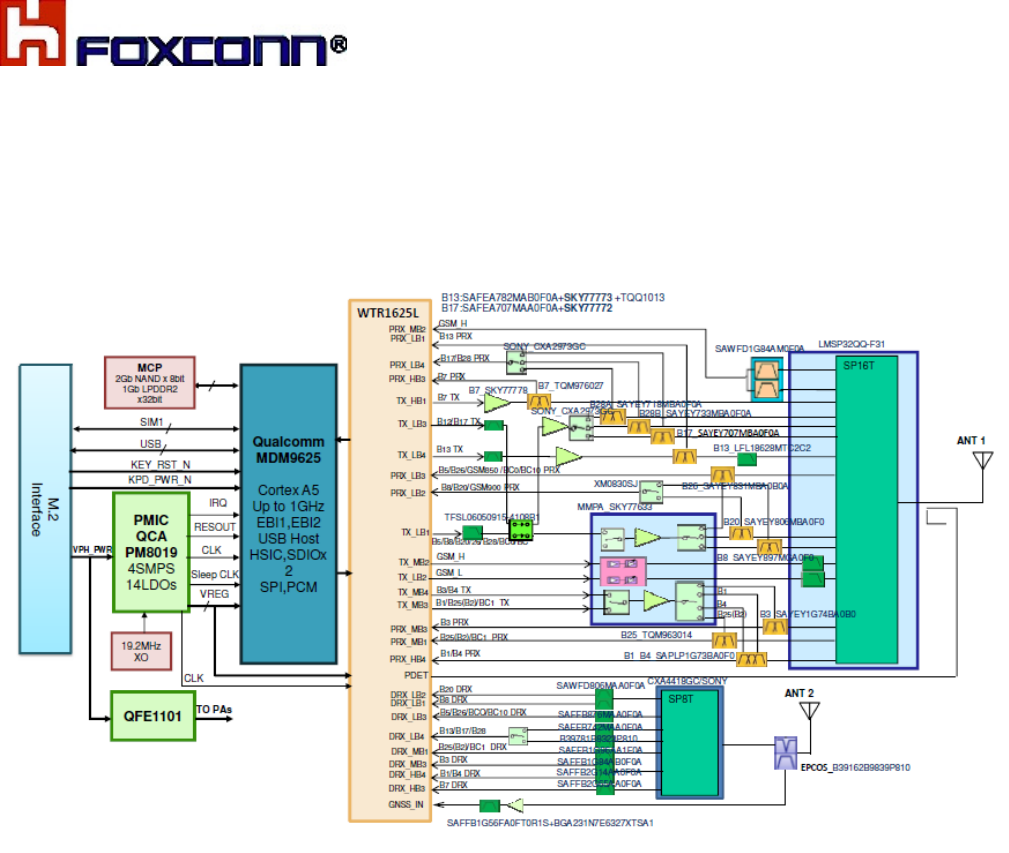
COMPANY CONFIDENTIAL
9
1.2 System Block Diagram
Figure 1-1 System block diagram
Chipsets: MDM9625+WTR1625L+PM8019+QFE1101
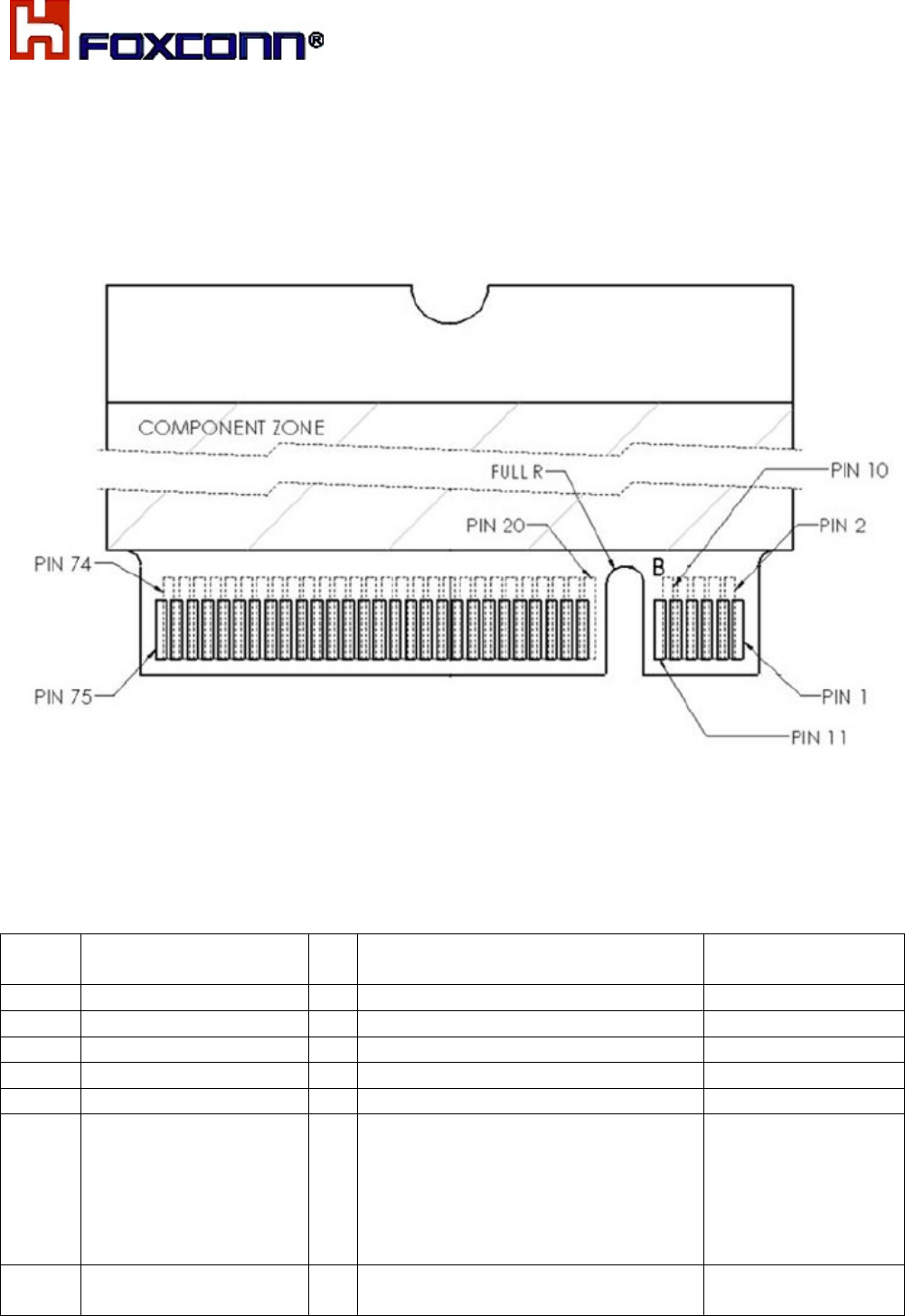
COMPANY CONFIDENTIAL
10
1.3 Pin definition
1.3.1 Golden finger Pin sequence
Figure 1-2 shows the sequence of pins on the 75-pin signal interface of M.2 3042.
1.3.2 Pin definition
Table 1-1 M.2 Pin definition
No. M.2 Pin name I/O
Description Platform
connection
1 CONFIG_3 O Connected to Ground internally.
2 3.3V PI Power supply (3.1V-4.4V)
3 GND PI Ground
4 3.3V PI Power supply (3.3V+/-5%)
5 GND PI Ground
6 Full_Card_Power_Off
(0/1.8V or 0/3.3V)
I When it is Low, M.2 card powers
off.
When it is High, M.2 card powers
on.
Pull down on card, should be
tolerant of 3.3V
7 USB_D+ IO
USB Data+ defined in the USB
2.0 Specification.

COMPANY CONFIDENTIAL
11
8 W_DISABLE#1
(0/3.3V)
I Active low signal used by the host
to turn on/off radio operation.
When it is Low, radio off.
When it is High, radio on.
9 USB_D- IO
USB Data- defined in the USB 2.0
Specification.
10 LED#1 O Active low signal, used to allow
the M.2 card to provide status
indicators via LED devices that
will be provided by the system.
11 GND PI Ground
12~19
Notch - Notch
20 AUDIO_0 - Don’t need to connect to platform;
Connect to MDM9xxx
PRIM_PCM_CLK
21 CONFIG_0 O Not connect internally.
22 AUDIO_1 - Don’t need to connect to platform;
Connect to MDM9xxx
PRIM_PCM_SYNC
23 WoWWAN (0/1.8V) O WWAN to wake up the host, It is
active low.
24 AUDIO_2 - Don’t need to connect to platform;
Connect to MDM9xxx
PRIM_PCM_DIN
25 DPR (0/1.8V) I Hardware pin for BodySAR
Detection
H: No TX power backoff (default)
L: TX power backoff
26 W_DISABLE#2 I GPS disable:
H:Turn on GPS/GLONASS
(default)
L: Turn off GPS/GLONASS
27 GND PI Ground
28 AUDIO_3 - Don’t need to connect to platform;
Connect to MDM9xxx
PRIM_PCM_DOUT
29 SSIC-TxN - Don’t need to connect to platform;
Connect to MDM9xxx SPI_MOSI
30 UIM-RESET O UIM-RESET
31 SSIC-TxP - Don’t need to connect to platform;
Connect to MDM9xxx SPI_MISO
32 UIM-CLK O UIM-CLK
33 GND PI Ground
34 UIM-DATA IO
UIM-DATA
35 SSIC-RxN - Don’t need to connect to platform;
Connect to MDM9xxx SPI_CS_N
36 UIM-PWR O UIM-PWR

COMPANY CONFIDENTIAL
12
37 SSIC-RxP - Don’t need to connect to platform;
Connect to MDM9xxx SPI_CLK
38 N/C - Don’t need to connect to platform;
Connect to MDM9xxx
USB_HS_ID
39 GND PI Ground
40 GNSS_SCL (0/1.8V*)
IO
I2C_CLK, Don’t need to connect
to platform
41 NC - Don’t need to connect to platform;
Connect to MDM9xxx
UART_CTS_N
42 GNSS_SDA
(0/1.8V*)
IO
I2C_DATA, Don’t need to connect
to platform
43 NC - Don’t need to connect to platform;
Connect to MDM9xxx
UART_RFR_N
44 GNSS_IRQ (0/1.8V*)
IO
I2C_IRQ, Don’t need to connect
to platform
45 GND PI Ground
46 SYSCLK (0/1.8V*) O Don’t need to connect to platform;
Connect to PMIC XO
47 NC - Don’t need to connect to platform;
Connect to MDM9xxx
MDM_UART_TX
48 TX_BLANKING I Don’t need to connect to platform;
49 NC - Don’t need to connect to platform;
Connect to MDM9xxx
MDM_UART_RX
50 NC - Not connect
51 GND PI Ground
52 Reserve - MDM_WLAN_SD2_D1
53 Reserve - MDM_WLAN_SD2_D3
54 Reserve - MDM_WLAN_SD2_D0
55 Reserve - MDM_WLAN_SD2_D2
56 Reserve - MDM_WLAN_SD2_CLK
57 GND PI Ground
58 Reserve - MDM_WLAN_SD2_CMD
59 ANTCTL0 (0/1.8V) O Tunable antenna control signal,
bit 0
60 COEX3 (0/1.8V) IO
For LTE/WLAN co-existence;
LTE_WLAN_PRIORITY
61 ANTCTL1 (0/1.8V) O Tunable antenna control signal,
bit 1
62 COEX2 (0/1.8V) IO
For LTE/WLAN co-existence;
LTE_FRAME_SYNC
63 ANTCTL2 (0/1.8V) O Tunable antenna control signal,
bit 2
64 COEX1 (0/1.8V) IO
For LTE/WLAN co-existence;

COMPANY CONFIDENTIAL
13
LTE_ACTIVE
65 ANTCTL3 (0/1.8V) O Tunable antenna control signal,
bit 3
66 SIM Detect I SIM_SWP
67 Reset# (0/1.8V) I System reset
68 SUSCLK(32kHz)
(0/3.3V)
- Reserve
69 CONFIG_1 O Connected to Ground internally.
70 3.3Vaux PI Power supply (3.3V+/-5%)
71 GND PI Ground
72 3.3Vaux PI Power supply (3.3V+/-5%)
73 GND PI Ground
74 3.3Vaux PI Power supply (3.3V+/-5%)
75 CONFIG_2 O Connected to Ground internally.
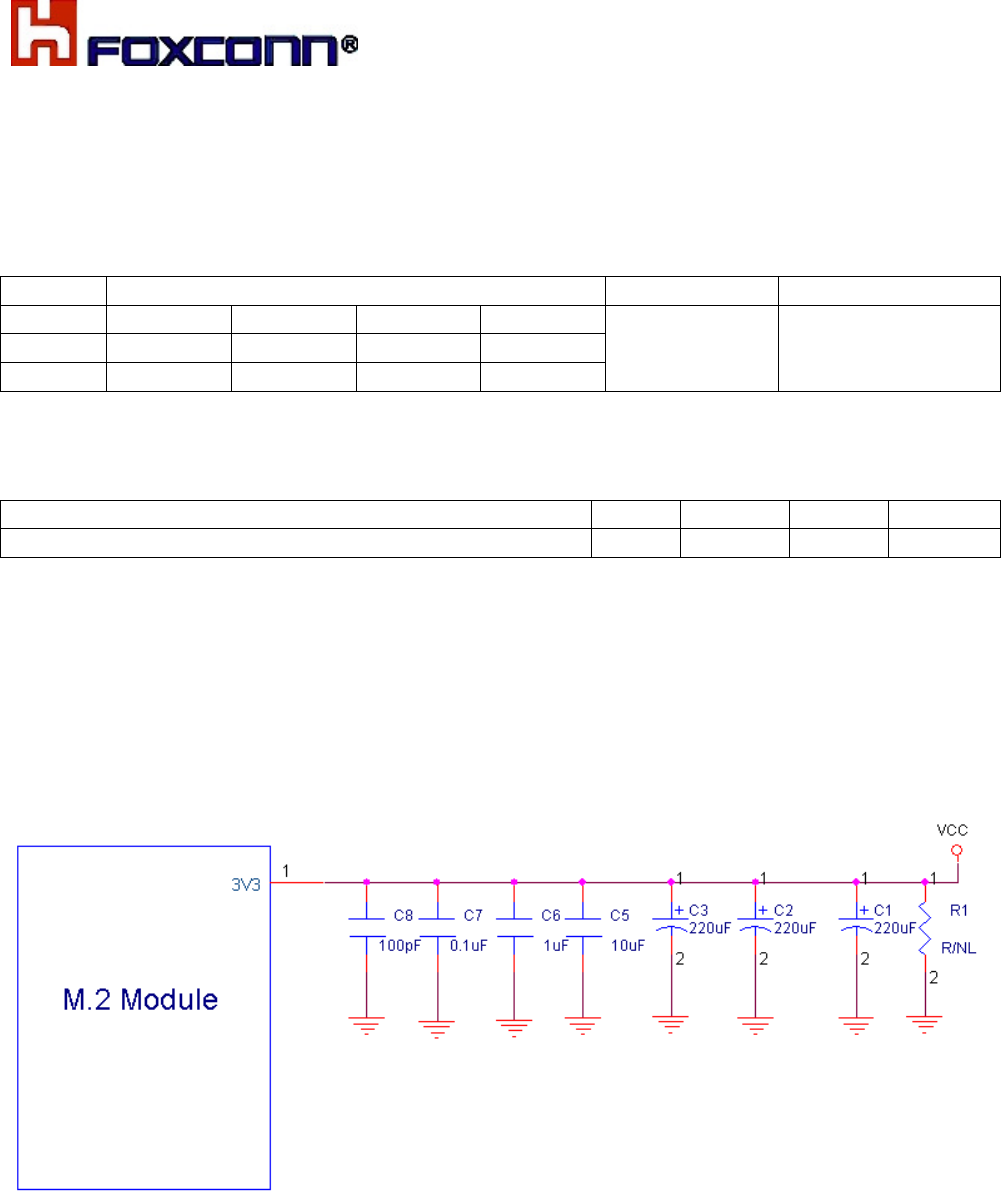
COMPANY CONFIDENTIAL
14
1.4 Platform connection design
1.4.1 Configuration Pins
The M.2 module provides 4 configuration pins. T77W595 is configured as WWAN-SSIC 0,
refer to PCIe M.2_Rev 1.0.
Item Module configuration decodes Module type Port configuration
Config Config_0
Config_1
Config_2
Config_3
WWAN-SSIC
0 Pin No.
21 69 75 1
State NC GND GND GND
1.4.2 Power and ground
(1) Power Rail Parameters
Parameter Min Type Max Units
Operating voltage 3.135
3.3 4.4 Vdc
The operating voltage was defined in PCIe M.2_Rev 1.0 standard as 3.135V~4.4V.
(2) 3.135 V is the minimum voltage supplied to LTE M.2 card by the host platform, and VCC
must never be under 3.135 V in any case. As our experiment, if we set the VCC=3.0V, the
M.2 card will power off when M.2 card working at +23dBm continue mode.
(3) Whenever the M.2 module works at 2G mode, the module transmits at the maximum
power (like +33dBm), the transient peak current may reach to 2.5 A.
We recommended design the VCC supply of host as below:
Remark: When the system power restarts, reserve R1 to discharge power.
(4) The LTE M.2 module provides 5 power pins and 11 Ground pins. To ensure that the LTE
module works normally, all the pins must be connected.
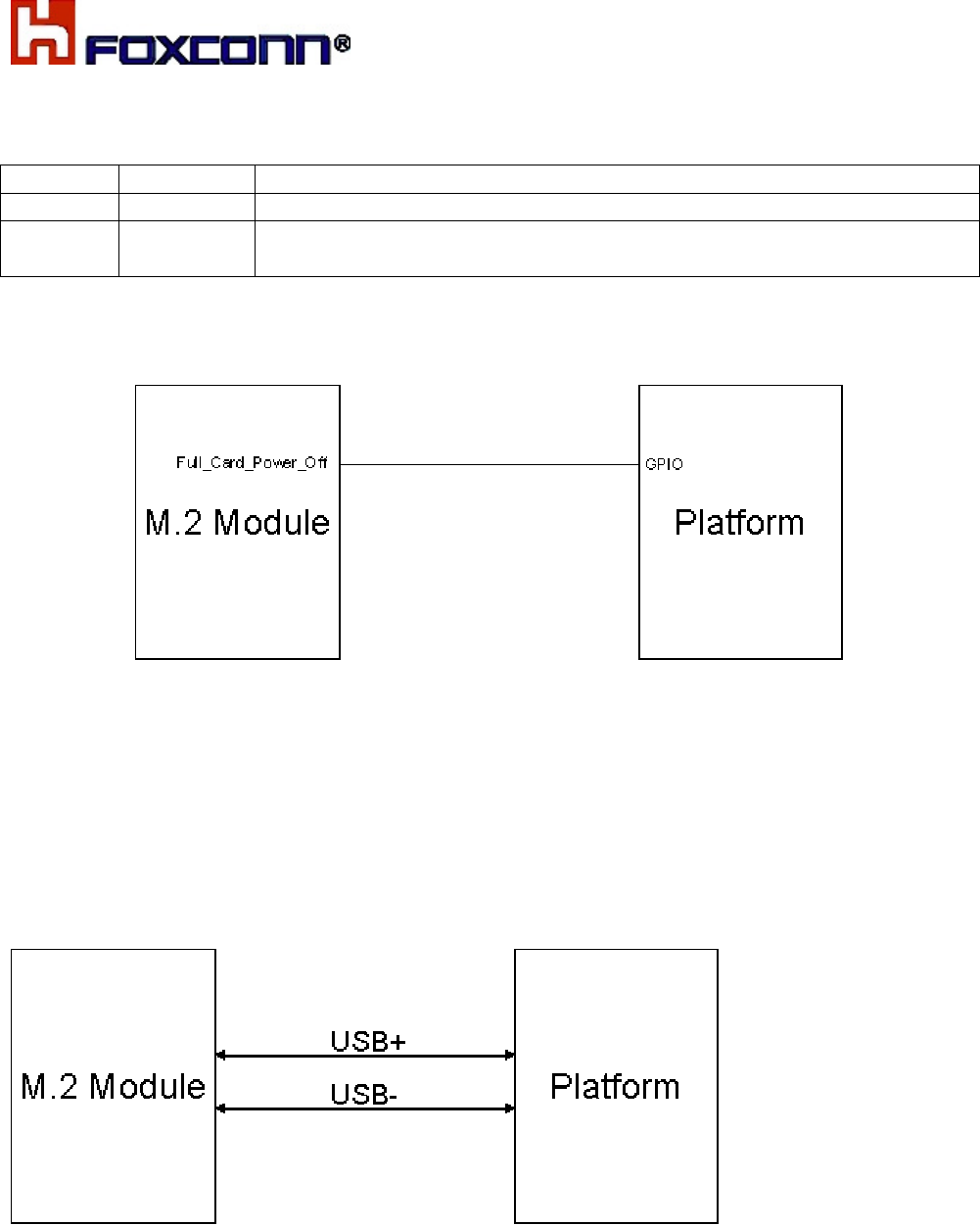
COMPANY CONFIDENTIAL
15
1.4.3 Full_Card_Power_Off
The M.2 LTE module can be controlled to power on/off by the Full_Card_Power_Of pin.
Item State M.2 card state
1 Low Powers off, It’s internally pulled down by 100K ohm resistor
2 High Powers on, it is 3.3V tolerant but can be driven by either 1.8V or
3.3V GPIO.
The recommended connections as below
1.4.4 USB interface
T77W595 module is compliant with USB2.0 in all three modes (Low speed, Full speed, and
high speed). When two devices are connected via a USB interface, one of the devices must
act as a host, and the other device must act as a peripheral. The host is responsible for
initiating and controlling traffic on the bus.
Figure 1-4-4 USB2.0 interface
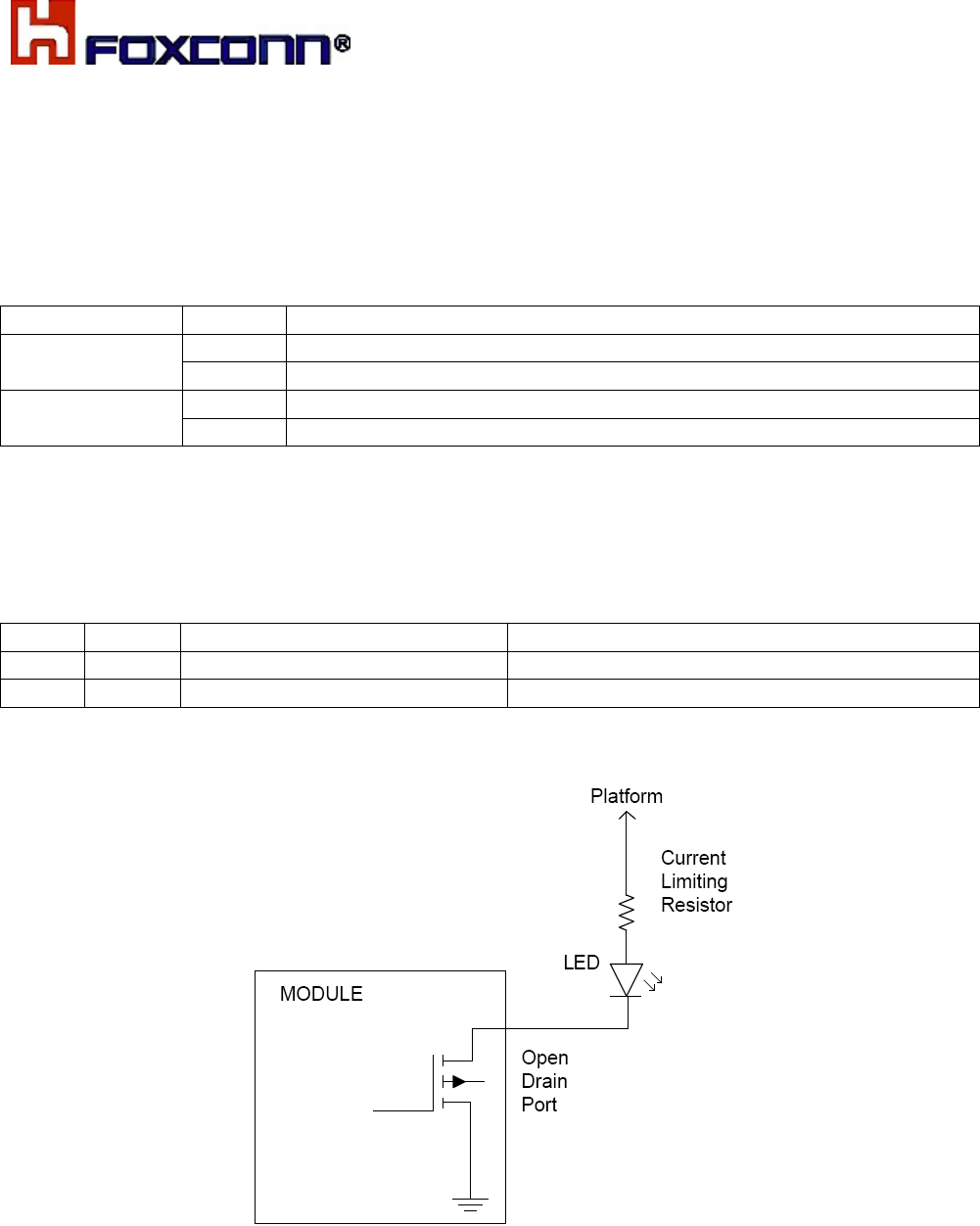
COMPANY CONFIDENTIAL
16
1.4.5 W_DISABLE#
This control setting is implementation-specific and represents the collective intention of the
host software to manage radio operation. T77W595 provides a hardware pin (W_DISABLE#)
to disable or enable the radio. Besides, the radio can also be enabled or disabled through
software AT commands.
Item State Function (WWAN state)
W_DISABLE#1
Low WWAN Disabled (no RF operation allowed)
High WWAN Enabled (RF operation allowed), internally pull up
W_DISABLE#2
Low GPS Disabled (no RF operation allowed)
High GPS Enabled (RF operation allowed), internally pull up
1.4.6 LED Indication
The LED signal is provided to enable wireless communication add-in cards to provide status
indications to users via system provided indicators
(1) State of the LED# pin
Item State Definition Interpretation
1 Low The LED is emitting light. Radio is capable of transmitting.
2 High The LED is emitting no light. Radio is incapable of transmitting.
(2) Typical LED Connection in Platform/System
.
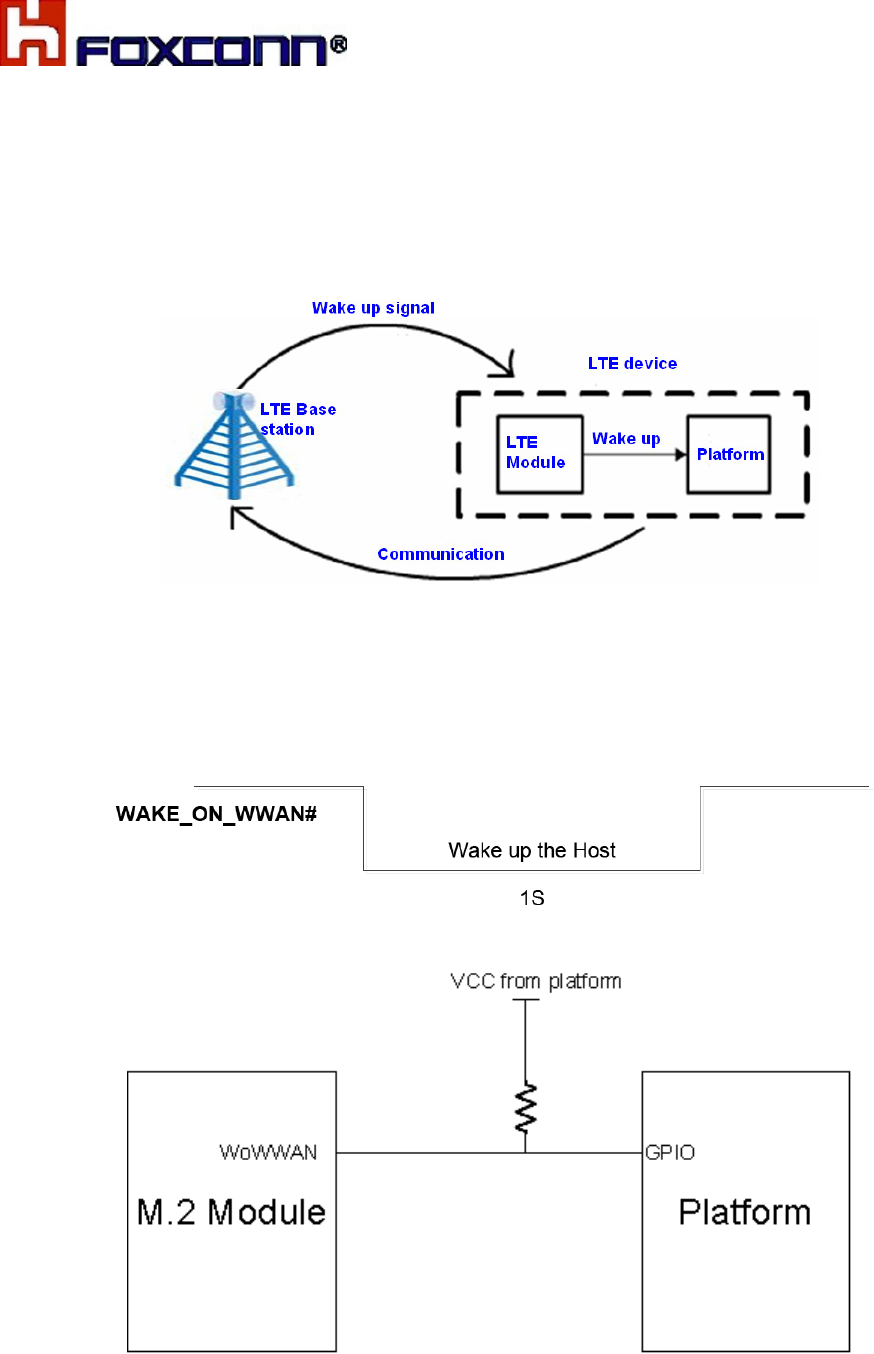
COMPANY CONFIDENTIAL
17
1.4.7 WoWWAN
The WAKE_ON_WWAN# signal is for power saving.
•LTE module always listening at very low power in idle mode
•LTE module will wake up mother board via ‘WoWWAN’ signal.
•The platform will power on when triggered by the LTE module.
The WAKE_ON_WWAN# signal is used to wake up the host. It is open drain and should be
pulled up at the host side. When the WWAN needs to wake up the host, it will output a one
second low pulse, shown in Figure 1-4-6.
Typical Connection in Platform/System
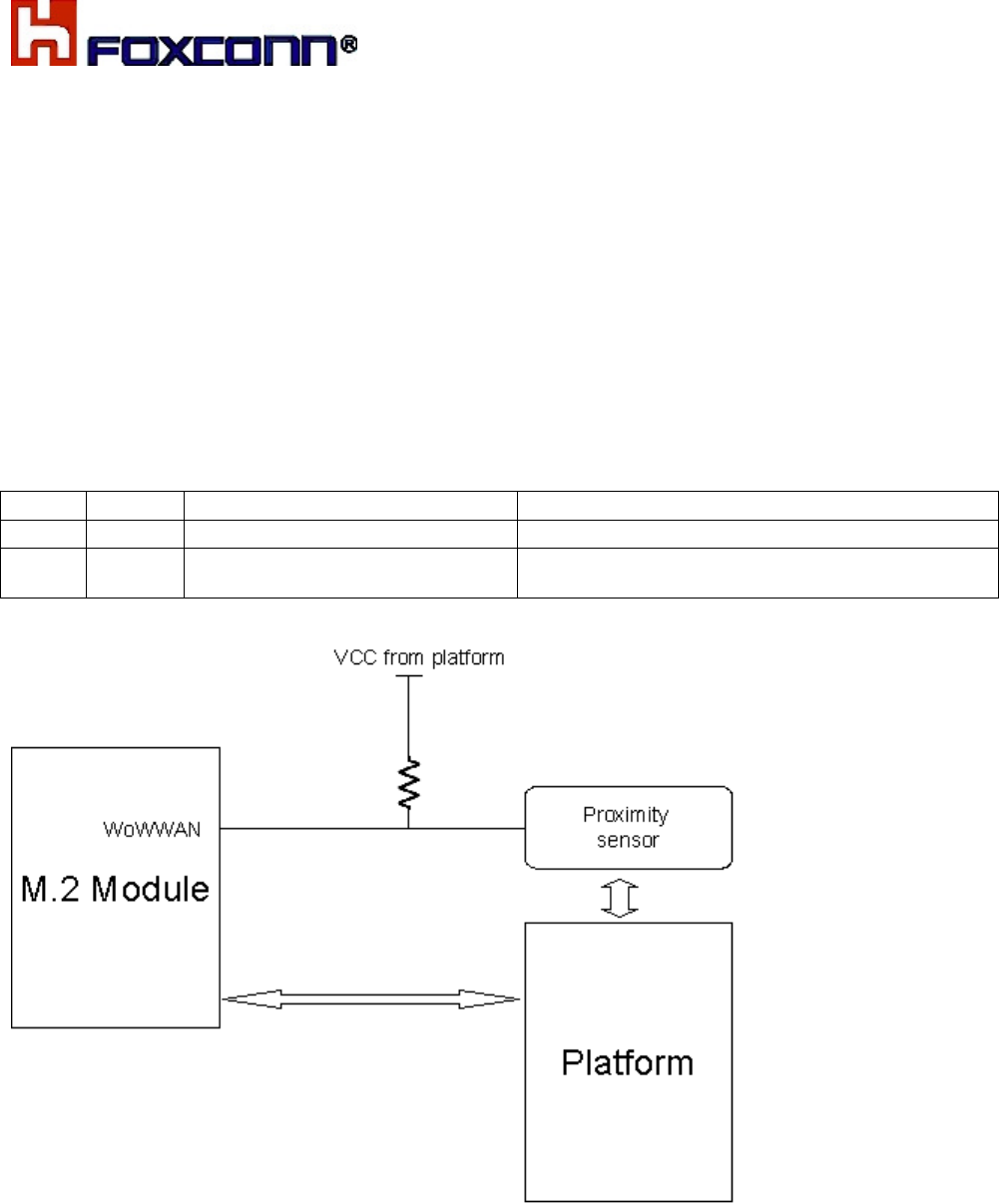
COMPANY CONFIDENTIAL
18
1.4.8 DPR (Dynamic Power Reduction)
The optional DPR signal is used by wireless devices to assist in meeting regulatory SAR
(Specific Absorption Rate) requirements for RF exposure. The signal is provided by a host
system proximity sensor to the wireless device to provide an input trigger causing a
reduction in the radio transmit output power.
The required value of the power reduction will vary between different host systems and is
left to the host platform OEM and card vendor to determine, along with the specific
implementation details. The assertion and de-assertion of DPR is asynchronous to any
system clock. All transients resulting from the proximity sensor need to be de-bounced by
system circuitry.
(1) State of the DPR
Item State Definition Interpretation
1 Low
Enable the SAR power back off.
Radio is capable of transmitting.
2 High
Disable the SAR power back off,
internally pull up
Radio is incapable of transmitting.
(2) Typical Connection in Platform/System
Remark:
a. The proximity sensor was controlled by the platform side.
b.
After DPR pin becomes low level, you can set the MAX TX power by AT commands..
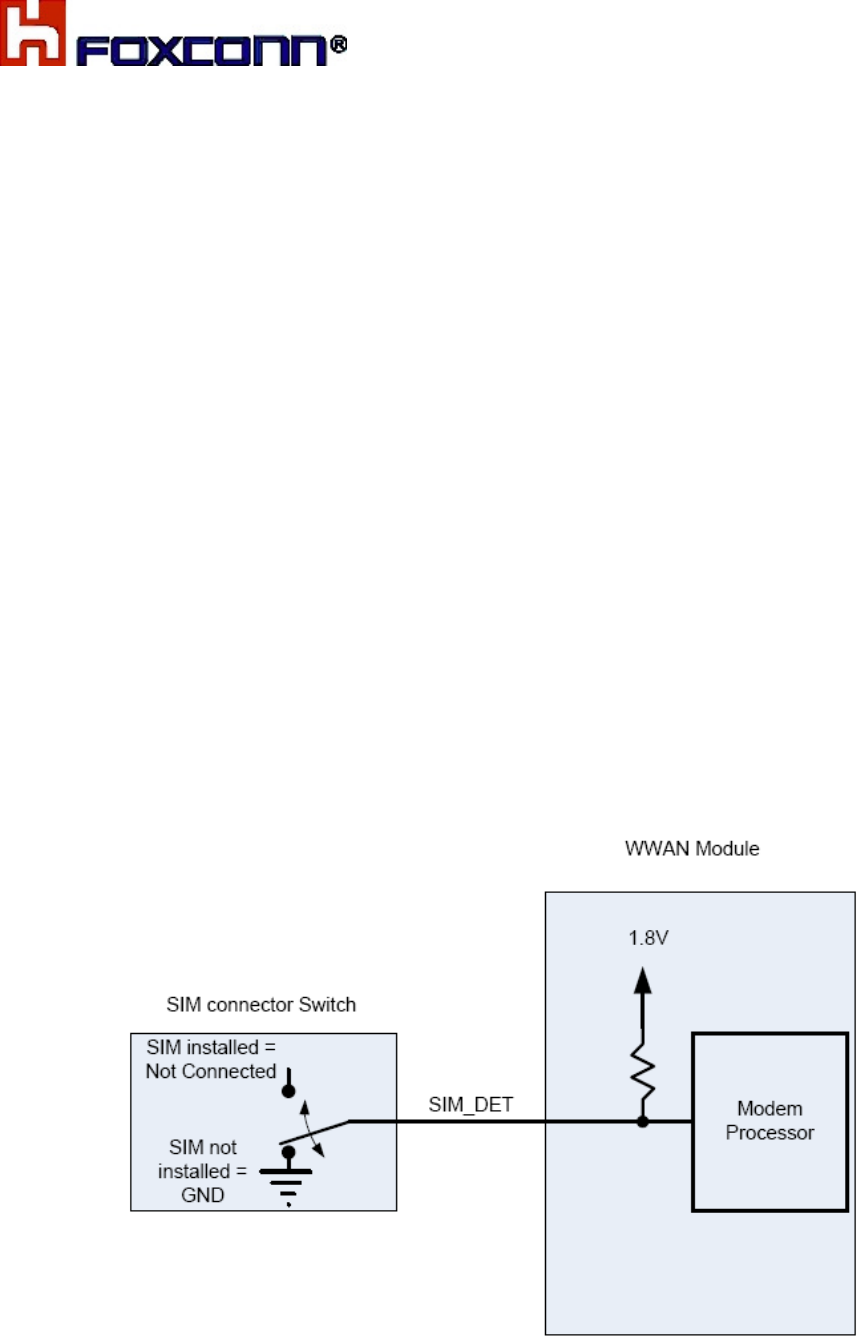
COMPANY CONFIDENTIAL
19
1.4.9 USIM
The UIM contains parameters necessary for the WWAN device’s operation in a wireless
wide area network radio environment. The UIM signals are described in the following
paragraphs for M.2 add-in cards that support the off-card UIM interface.
(1) USIM card socket
It is recommended to take electrostatic discharge (ESD) protection measures near the USIM
card socket. The USIM socket should be placed near the NGFF interface (<100 mm),
because a long circuit may impact signal quality.
(2) UIM-PWR
UIM_PWR power supply can supply 1.8 V and 2.85 V power to UIM card and auto detects
follow SIM card type
(3) SIM Detect
This signal is used to detect the insertion and removal of a SIM device in the SIM socket.
With a Normal Short SIM Card connector, PUSH-PUSH type, the detect switch is normally
shorted to ground when no SIM card is inserted. When the SIM is inserted, the
SIM_DETECT will transition from logic 0 to logic 1 state. The rising edge will indicate
insertion of the SIM card. When the SIM is pulled out, the SIM_DETECT will transition from
logic1 to logic 0. This falling edge will indicates the pulling out of the SIM card. The M.2
module monitoring this signal will treat the rising/falling edge or the actual logic state as an
interrupt, that when triggered, the module will act accordingly.
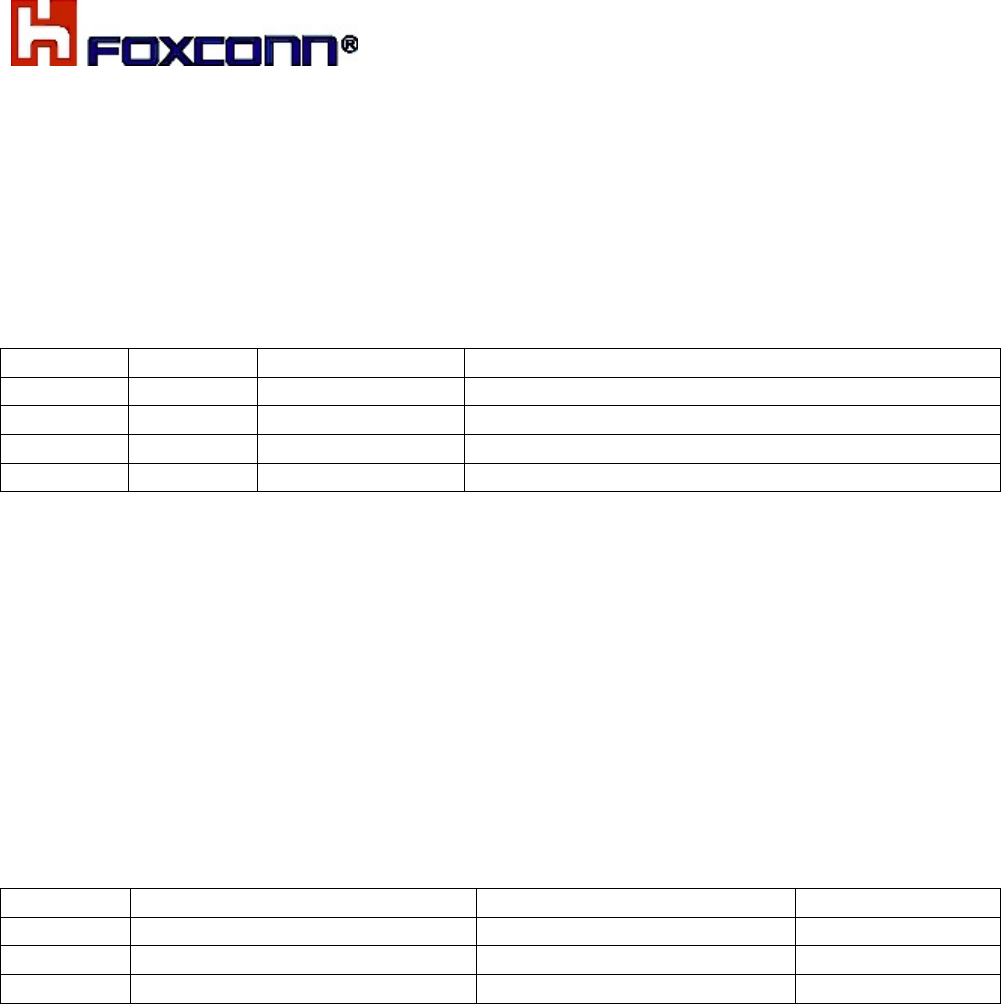
COMPANY CONFIDENTIAL
20
1.4.10 Antenna Control
T77W595 provides GPIO control signals for external antenna tuner application. The function
is under development for customization. ANTCTRL (0-3) are provided to allow for the
implementation of antenna tuning solutions. The number antenna control lines required will
depend on the application and antenna/band requirements.
Foxconn general design for WWAN module with two control signals.
ANTCTL0
ANTCTL1
Frequency (MHz)
Band support
0 0 880 ~ 960 Band8 (WCDMA) + GSM900 + High Bands
0 1 791 ~ 894 Band5 (WCDMA, LTE) + GSM850 + High Bands
1 0 746 ~787 Band13 (LTE) + High Bands
1 1 704 ~746 Band17 (LTE) + High Bands
1.4.11 Coexistence
COEX1, COEX2 and COEX3 are provided to allow for the implementation of wireless
coexistence solutions between the radio(s) on the M.2 Card and other off-card radio(s).
These other radios can be located on another M.2 Card located in the same host platform or
as alternate radio implementations (for example, using a PCI Express M.2 CEM or a
proprietary form-factor add-in solution).
Reserve for future extension, please contact with us if need to use these Pins.
Item Signal name GPIO from MDM9x15 Description
COEX1 LTE_ACTIVE
GPIO_51
TBD
COEX2 LTE_FRAME_SYNC
GPIO_52
TBD
COEX3 LTE_WLAN_PRIORITY
GPIO_53
TBD
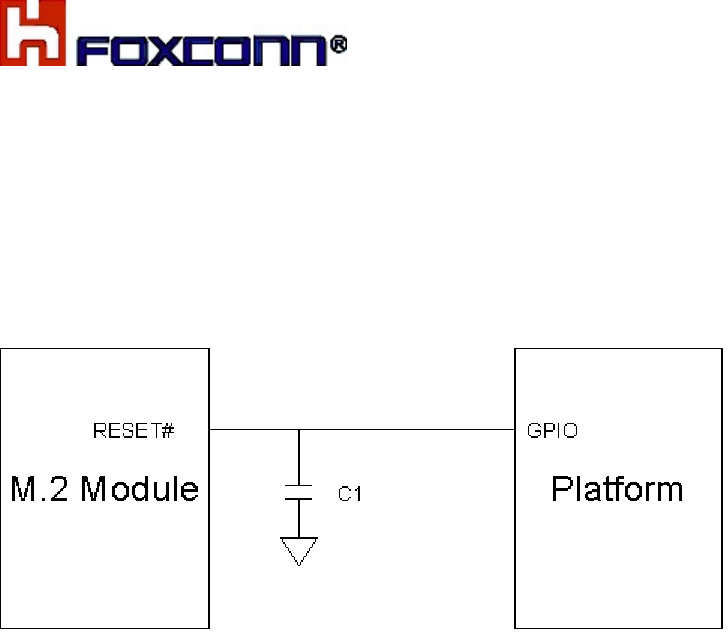
COMPANY CONFIDENTIAL
21
1.4.12 RESET#
Asynchronous RESET# pin, active low. Whenever this pin is active, the modem will
immediately be placed in a Power On reset condition. Care should be taken not to activate
this pin unless there is a critical failure and all other methods of regaining control and/or
communication with the WWAN sub-system have failed.
The Reset# signal is relatively sensitive, it is recommended to install one capacitor
(10~100pF) near to the M.2 card pin.

COMPANY CONFIDENTIAL
22
2. Hardware features
T77W595.00 consists of the following key engine components, in addition to the required
front-end RF and other discrete components.
Modem engine
■ Soft Baseband: MDM-9625
■ RF: WTR1625L
■ Power: PM8019
Connectivity engine
■ USB: USB2.0 high-speed
■ USIM: located off board
■ Antenna: connectors for the off board antennas
2.1 Mobile Data Modem
The MDM9625 chipset solution integrates powerful digital signal processors (DXPs) into any
market-proven wireless modem, offering increased processing capacity and lower power
consumption. They are complete system solutions that operate on networks worldwide. The
major functions of MDM9625 used on T77W595.00 are listed below:
❒ Processor:
- Manufactured in 28nm CMOS process
- System uP (Cortex-A5 + L2 cache at up to 1 GHz)
❒ Memory:
- External memory (16KB for security)
EBI1: 1Gb LPDDR1
- External memory
EBI2: 2Gb NAND flash
❒ Air interface:
- WCDMA (R99, HSDPA, HSUPA, HSPA+, DC-HSPA+)
- CDMA (1x, EV-DOr0, EV-DOrA, EV-DOrB)
- LTE (R10 Cat4, FDD/TDD)
- GSM (GSM R99, GPRS, EDGE)
- GPS/Glonass
❒ Advance RX operation:
- Mobile receive diversity (WCDMA, CDMA and LTE)

COMPANY CONFIDENTIAL
23
❒ Connectivity:
- USB 2.0 HS with built-in USB PHY
- UART interface
- UIM support (dual voltage)
2.2 RF transceiver
The WTR1625L device is a highly integrated and versatile RF CMOS transceiver IC that can
be used in multimode, multiband applications – including Rx diversity. The WTR1605 IC is
the RF transceiver IC within compatible Qualcomm MDM9625 chipsets.
The WTR1625 IC integrates advanced receive and transmit features into a 5.47 × 5.47 ×
0.63 mm package to simplify handset design, minimize parts count, and reduce DC power
consumption. These advanced Rx/Tx features include:
Multimode, multiband RF transceiver functions:
GNSS receiver functions
Fully integrated LO generation and distribution circuits to support all the RF operating
band and mode combinations
Primary, diversity, and GNSS receivers that can operate simultaneously
Tx power detector for monitoring the transmit power levels
The GSM receiver can share the secondary paths with CDMA, WCDMA, and LTE
diversity receivers
Qualcomm’s intelligent receiver technology for CDMA modes:
Low operating voltages that help save battery current and allows the WTR IC power to
be supplied by the PMIC’s switching mode power supply (SMPS) circuits for even
greater power savings
2.3 Power management IC
T77W595.00 system uses the Qualcomm PM8019. Qualcomm has worked with Maxim
Integrated Products Inc. to develop a custom PMIC solution for use with the T77W595.00
platform.
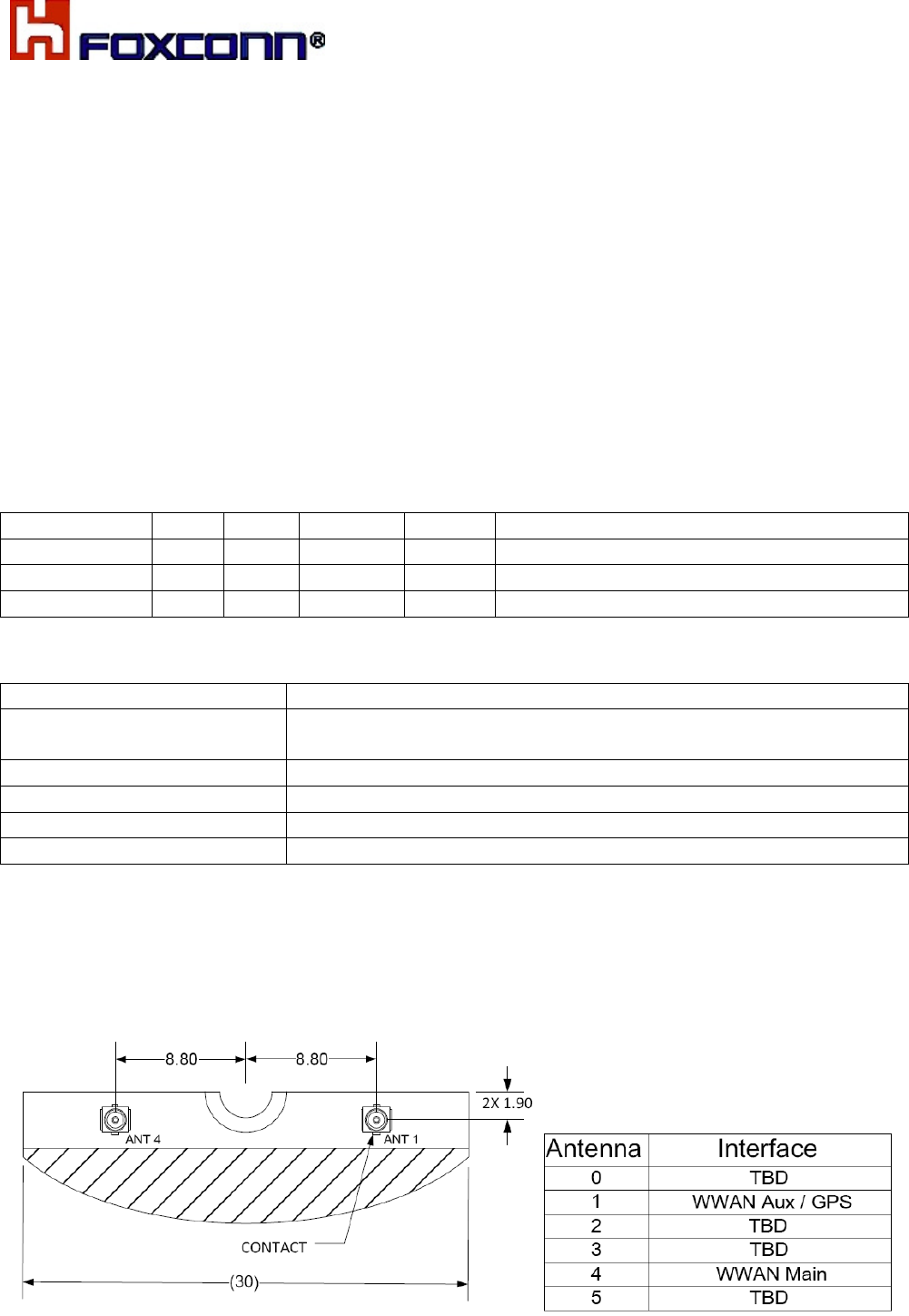
COMPANY CONFIDENTIAL
24
2.4 Antenna Design
2.4.1 Antenna specification
T77W595.00 also provides connectivity for off board antennas. The antennas and their
connection interface for this device satisfy the requirements specified in the PCI Express
M.2 Specification Revision Version 1.0 standard. The antenna elements are typically
integrated into the notebook/ultrabook /tablet and connected to T77W595.00 module via
flexible RF coaxial cables. T77W595.00 provides two RF connectors (MHF type), one for
the primary transmitter/receiver port and the other for the diversity receiver and GNSS.
To ensure stable RF performance, customer must assemble adequate antenna according to
the antenna specification.
Table 2-1 Main antenna specifications
Parameter Min.
Typ. Max. Units Notes
Cable loss / / 0.5 dB Maximum loss to antenna
Impedance / 50 / Ohm Antenna load impedance
VSWR / / 3:1 / Maximum allowed VSWR of antenna
Table 2-2 Aux antenna specifications
Parameter
Gain Maximum gain and uniform converge in high angle elevation
and zenith. Gain in the azimuth is not desired.
Average 3D gain >-5dBi
VSWR Typical value <3:1
Isolation(diversity to Main)
>10dB in all related bands
Polarization Any
2.4.2 Antenna location and mechanical design.
To ensure customer has a clear knowledge of the two antennas, check below product
picture.
Figure 2-1 Antenna connector location and type
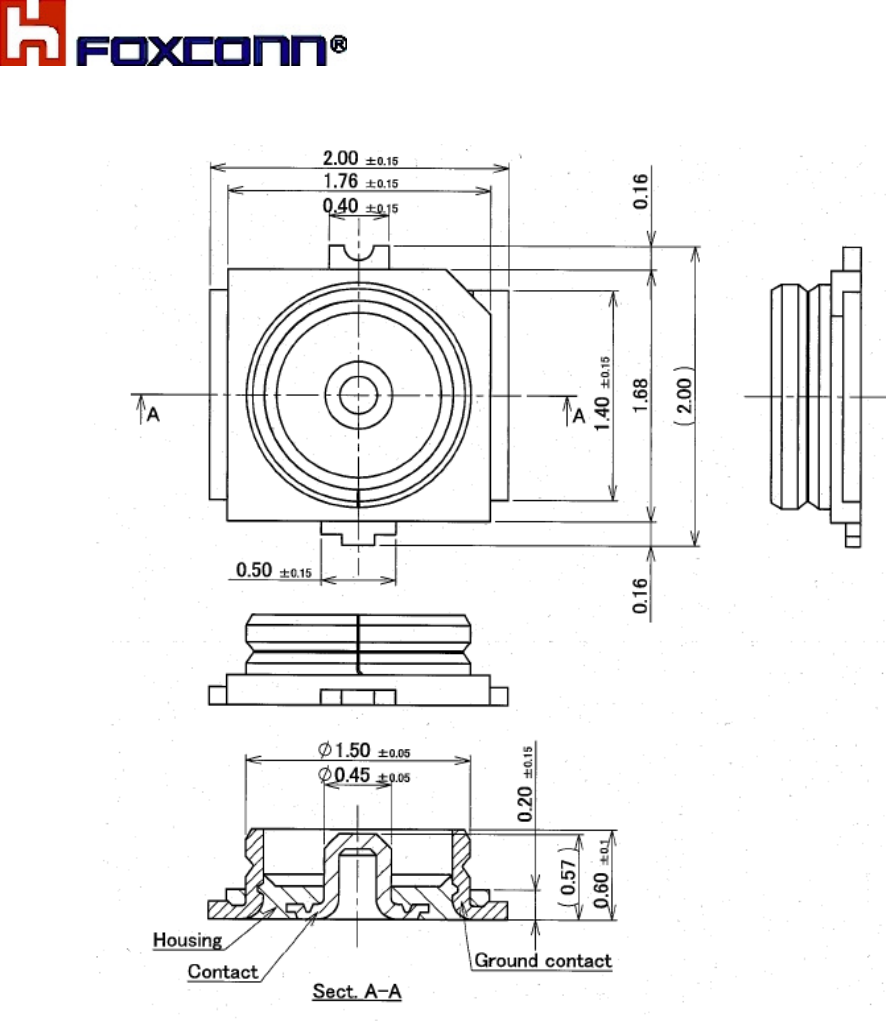
COMPANY CONFIDENTIAL
25
Figure 2-2 RF connectors
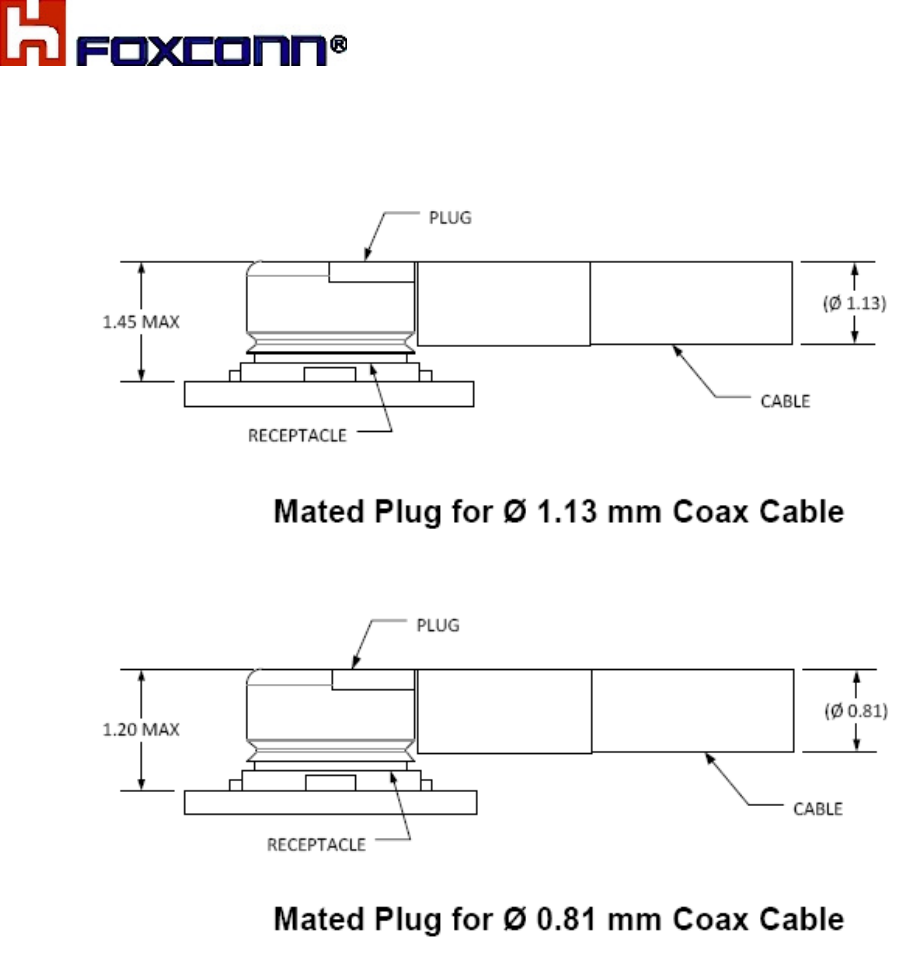
COMPANY CONFIDENTIAL
26
Figure 2-3 RF receptacles
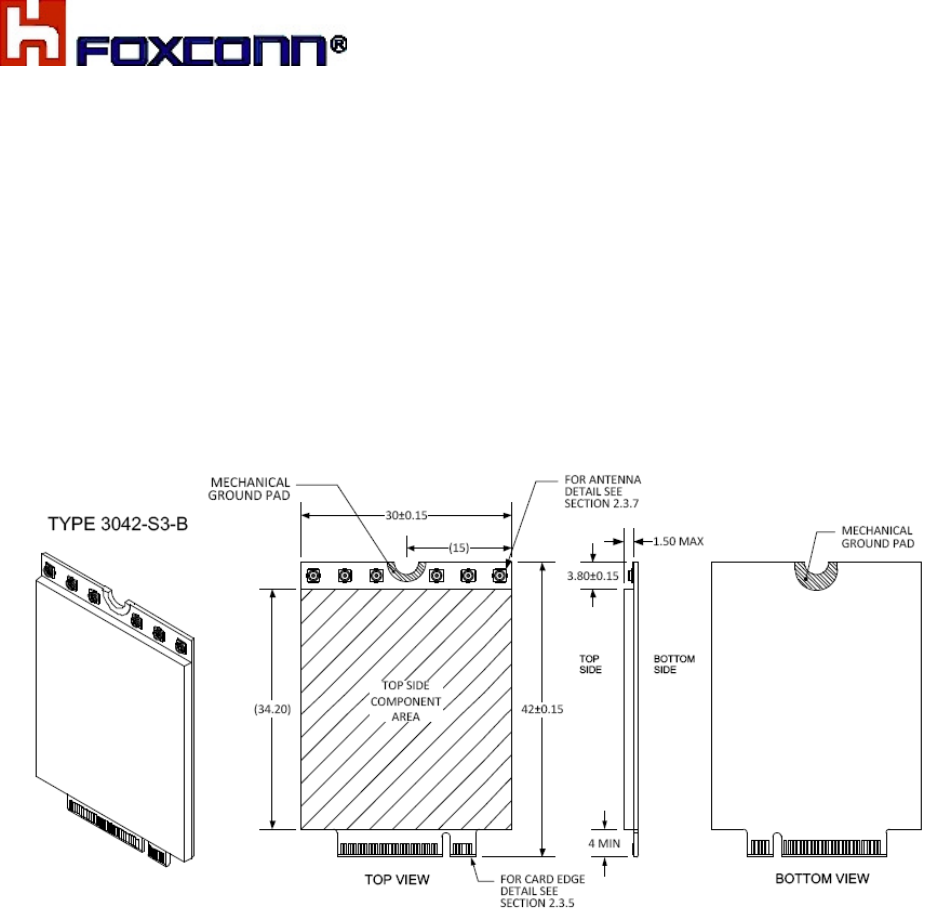
COMPANY CONFIDENTIAL
27
3. Mechanical Specifications
3.1 Overview
T77W595.00 is compatible with the PCI Express M.2 Specification 3042 type 75-pin card
edge-type connector. Refer to Electromechanical Specification Revision 0.7a, Version 1.0
with Input Power and Voltage Tolerance ECN for more details.
3.2 Mechanical constraints
Figure 3-1 shows the mechanical constraints of T77W595.00 (3042-S3-B)
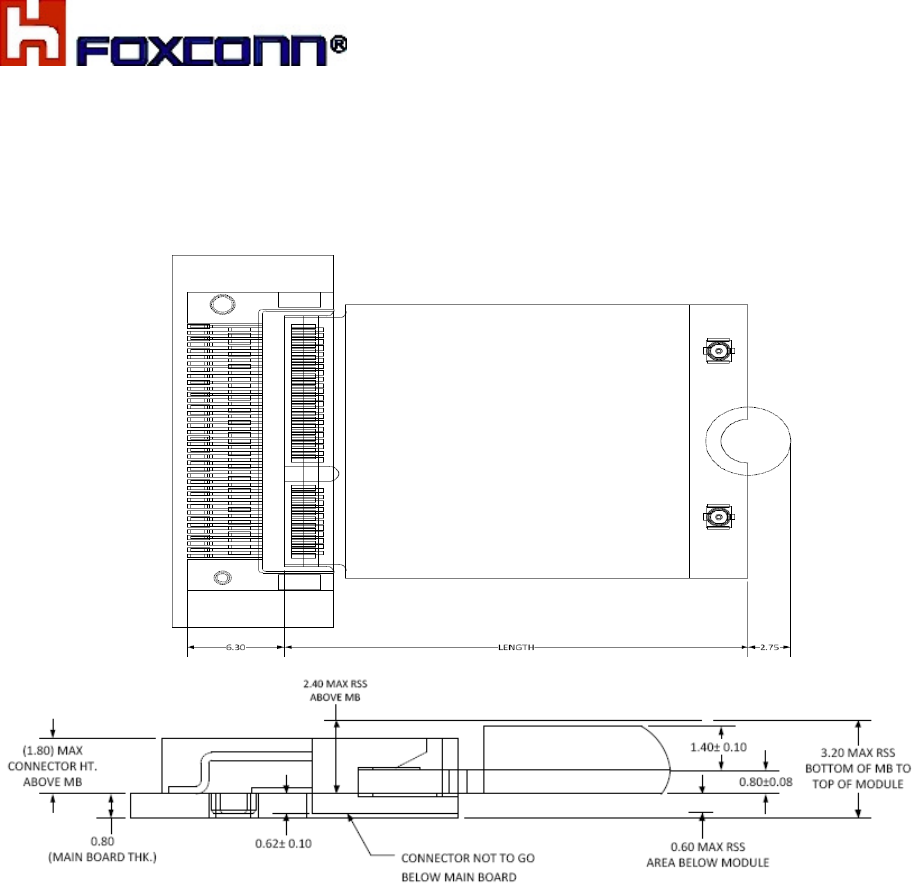
COMPANY CONFIDENTIAL
28
3.3 M.2 card assembly
Figure 3-2 shows Stack-up Mid-Line (In-line) Single Sided Module for 1.5 Maximum
Component Height, refer to section 2.4.8.3.1 of PCIe M.2_Rev 1.0 standard.
Remark:
a. 2.4mm maximum above mother board
b. Cut area of main board under M.2 module
c. Need to add thermal pad between M.2 module and mechanical component (like material
shielding) for thermal dissipation.
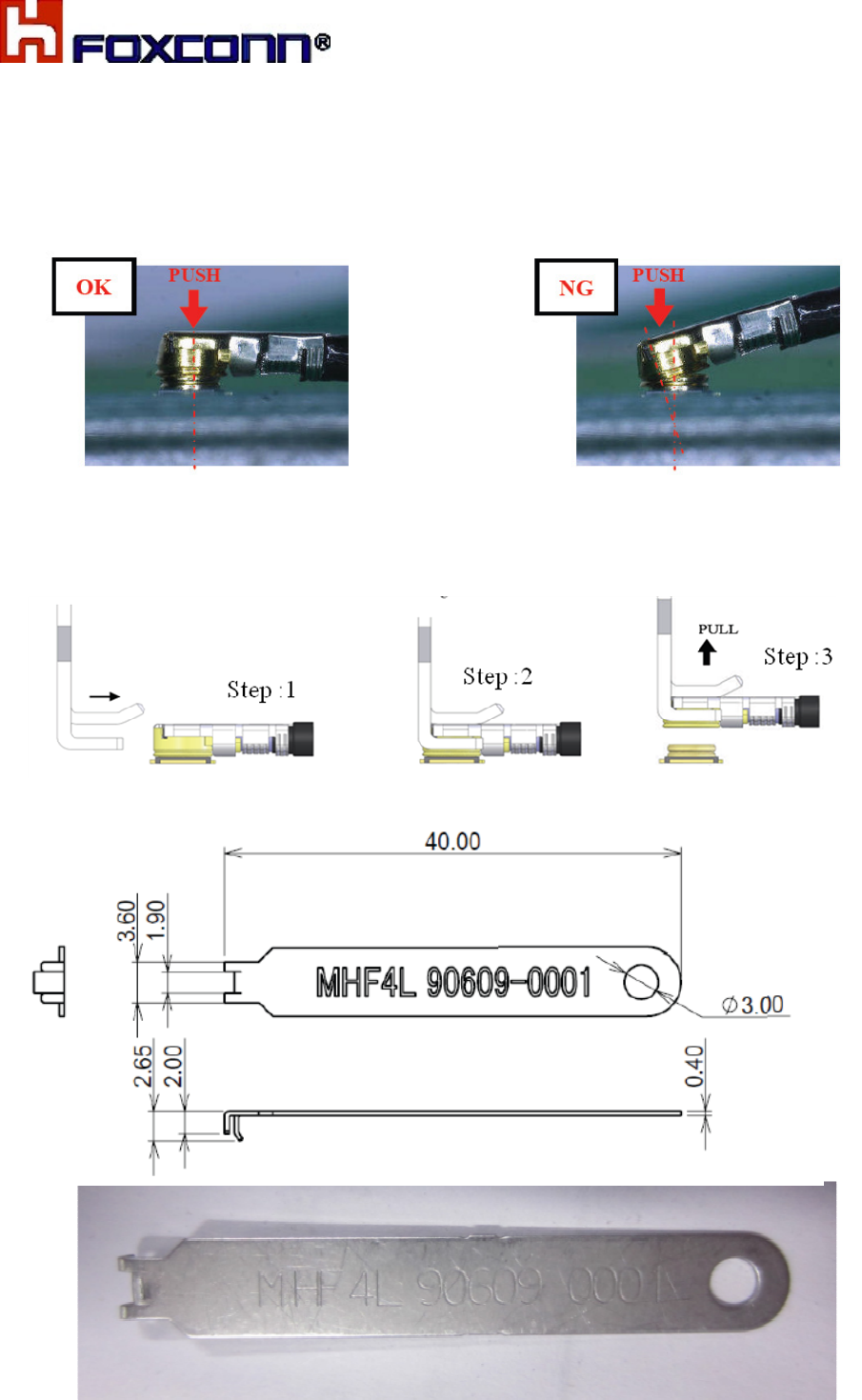
COMPANY CONFIDENTIAL
29
3.4 Connector assembly
a. Mate the connector vertically as much as possible. Adjusting the mating axis of plug
and receptacle. Do not slant mate.
.
b. Unmating: In case of unmating by pulling tool. Use the pulling tool as the following
drawing, and pull plug to vertical direction as directly as possible
c. Pulling tool(Unit:mm)

COMPANY CONFIDENTIAL
30
4. Electrical Specifications
4.1 Recommended operating conditions
Table 4-1 Recommended operating conditions
Parameter Min Type Max Units
Storage temperature -30 +25 +85 °C
Recommend operating temperature
(3GPP compliant)
-10 +25 +60 °C
Extend operating temperature
(operational, non-3GPP compliant)
-20 +25 +70 °C
Operating voltage 3.135
3.3 4.4 Vdc
Operating T77W595.00 device under conditions beyond its absolute maximum ratings
(Table 4-1) may damage the device. Absolute maximum ratings are limiting values to be
considered individually when all other parameters are within their specified operating ranges.
Functional operation and specification compliance under any absolute maximum condition,
or after exposure to any of these conditions, is not guaranteed or implied. Exposure may
affect device reliability
4.2 Power consumption
Table 4-2 Radio system power consumption
Test condition Sample
Test
Estimated power
range goal
(Typical)
Estimated power
range goal
(Max.)
GSM in suspend mode TBD <5mA
GSM (Tx=33dBm single slot) TBD
<500mA <2800mA
WCDMA in suspend mode TBD
<5mA
WCDMA (Tx=24dBm) TBD
<800mA <1100mA
CDMA in suspend mode TBD
<4mA
CDMA (Tx=24dBm) TBD
<700mA <1000mA
LTE in suspend mode TBD
<5mA
LTE (16QAM) Tx=23 dBm TBD
<900mA <1200mA
GPS/GNSS tracking TBD
<150mA <300mA
Connected standby TBD
<3mA
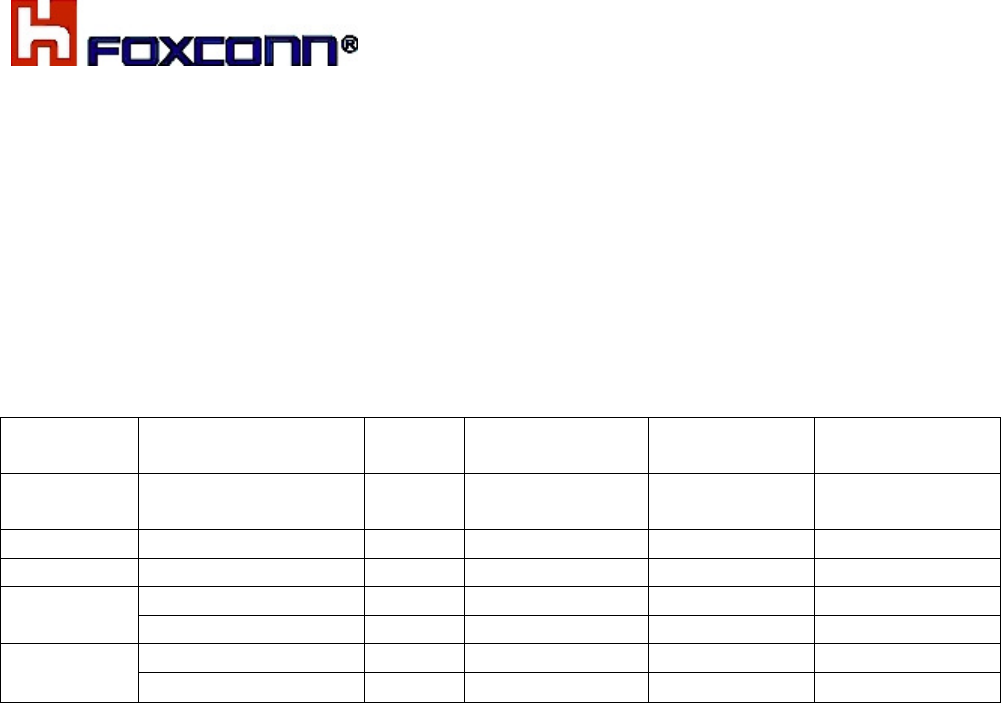
COMPANY CONFIDENTIAL
31
5. RF performance specifications
Radio performance for T77W595.00 is given in the following sections, including RF receiver,
RF transmitter.
5.1 RF maximum Tx power specifications
Table 5-1 Maximum transmit power
Remark:
Above table is for general application, please inform us if you have any further requirement.
Mode Band Class
3GPP
Standard
Design
Spec. MFG Spec.
LTE 1,2/25,3,4,5/26,
7,8,13,12/17,20,28
3 23+/-2 23+/-1 23+2/-1
WCDMA 1,2,4,5,8 3 24+1.7/-3.7 23.5+/-1 23.5+1/-2
CDMA BC0,BC1,BC10 3 23~30 24+0.5/-1 24+1/-1
GPRS 1800,1900 1 30+/-3 30+/-1 30+/-2
850,900 4 33+/-3 32 +/-1 33+/-2
E-GPRS 1800,1900 E2 26+/-3 25.5+/-1 26+/-2
850,900 E2 27+/-3 26.5+/-1 27+/-2
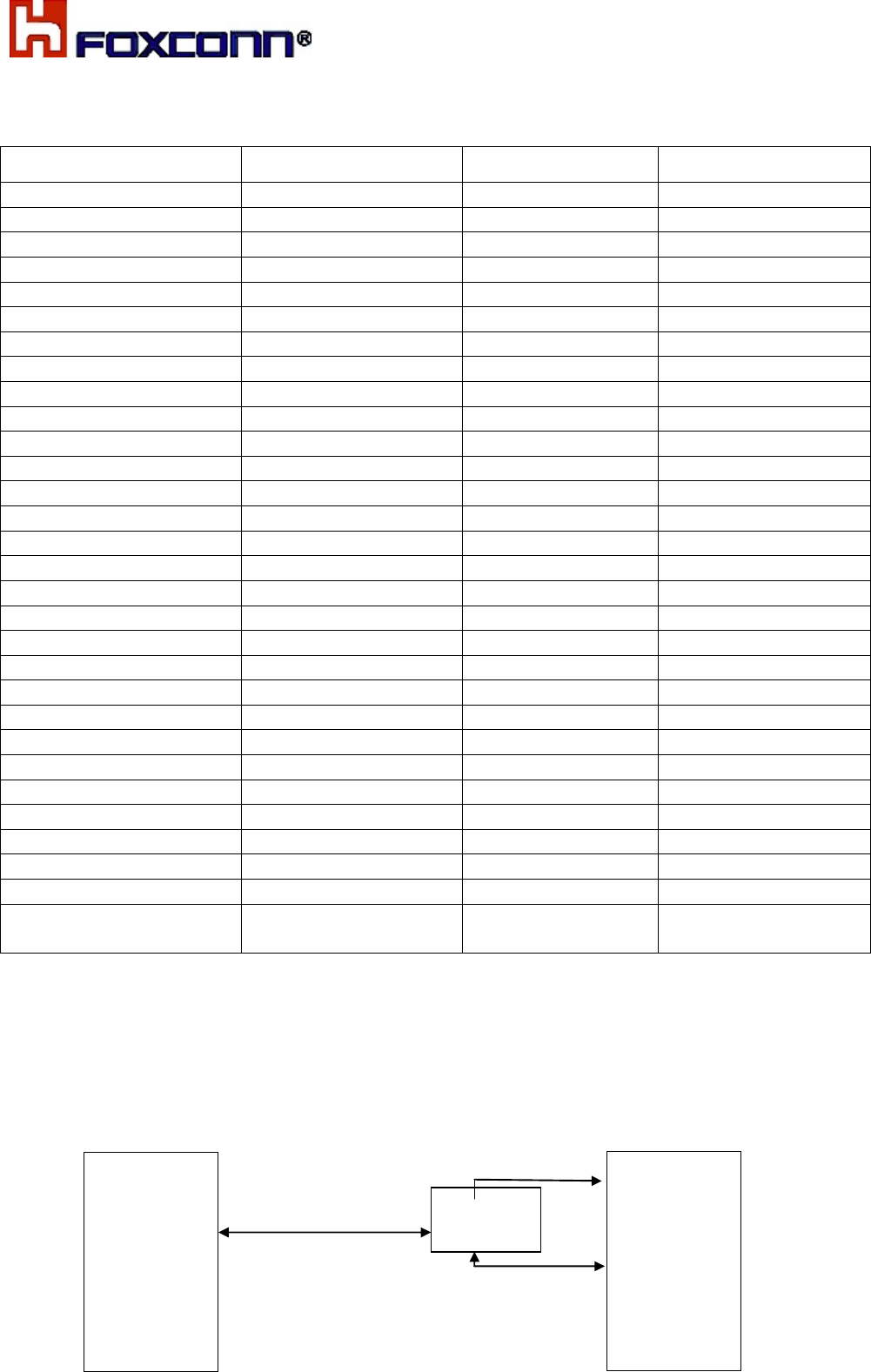
COMPANY CONFIDENTIAL
32
5.2 RF min. Rx sensitivity specifications
Table 5-2 Conducted min. receiver sensitivity
LTE Band (10MHz BW)
3GPP (Combined) Design Target MFG Spec
1 -97dBm -101 dBm -100 dBm
2 -95dBm -101 dBm -98 dBm
3 -94dBm -101 dBm -99 dBm
4 -97dBm -102 dBm -100 dBm
5 -95dBm -101 dBm -99 dBm
7 -95dBm -99 dBm -98 dBm
8 -94dBm -102 dBm -99 dBm
12 -94dBm -100 dBm -98 dBm
13 -94dBm -100 dBm -98 dBm
17 -94dBm -101 dBm -98 dBm
20 -94dBm -101 dBm -99 dBm
25 -93.5dBm -101 dBm -98 dBm
26 -94.5dBm -102 dBm -99 dBm
28 -95.5dBm -101 dBm -100 dBm
WCDMA 3GPP (Combined) Design Target MFG Spec
1 -106.7dBm -113 dBm -111 dBm
2 -104.7dBm -113 dBm -110 dBm
4 -106.7dBm -113 dBm -111 dBm
5 -104.7dBm -113 dBm -110 dBm
8 -103.7dBm -113 dBm -109 dBm
GPRS / E-GPRS 3GPP Design Target MFG Spec
GPRS 1800,1900 -102 dBm @ CS1 -109 dBm -107 dBm @ CS1
GPRS 850,900 -100 dBm @ CS1 -109.5 dBm -107 dBm @ CS1
EDGE 1800,1900 -98 dBm @ MCS5 -102 dBm -100 dBm @ MCS5
EDGE 850,900 -98 dBm @ MCS5 -102 dBm -100 dBm @ MCS5
CDMA 3GPP2 (Combined) Design Target MFG Spec
BC0 -104dBm -112dBm -109dBm
BC1 -104dBm -111dBm -109dBm
BC10 -104dBm -112dBm -109dBm
GPS/GLONASS
tracking sensitivity -152dBm -161dBm -155dBm
Remark:
a. It has 3dB margin at least refer to 3GPP standard or CDMA standard.
b. The typical value of LTE was measured as combine Rx sensitivity which was follow test
setup of 3GPP standard (TS36.521 charter 7.2 and charter 7.3.5), the test setup is follow
TS36.508 Annex A Figure A.3.
SS
RX/TX
RX
UE under Test
RX/TX
Ior
Îor
Splitter/
combiner

COMPANY CONFIDENTIAL
33
6. Software Features
6.1 USB Enumeration
When a USB device is attached to or removed from the USB, the host uses a process
known as bus enumeration to identify and manage the device state changes necessary.
When a USB device is attached to a powered port, the following actions are taken:
1. The hub to which the USB device is now attached informs the host of the event via a
reply on its status change pipe. At this point, the USB device is in the Powered state
and the port to which it is attached is disabled.
2. The host determines the exact nature of the change by querying the hub.
3. Now that the host knows the port to which the new device has been attached, the host
then waits for at least 100 ms to allow completion of an insertion process and for power
at the device to become stable. The host then issues a port enable and reset command
to that port.
4. The hub performs the required reset processing for that port. When the reset signal is
released, the port has been enabled. The USB device is now in the Default state and
can draw no more than 100 mA from VBUS. All of its registers and state have been
reset and it answers to the default address.
5. The host assigns a unique address to the USB device, moving the device to the
Address state.
6. Before the USB device receives a unique address, its Default Control Pipe is still
accessible via the default address. The host reads the device descriptor to determine
what actual maximum data payload size this USB device’s default pipe can use.
7. The host reads the configuration information from the device by reading each
configuration zero to n-1, where n is the number of configurations. This process may
take several milliseconds to complete.
8. Based on the configuration information and how the USB device will be used, the host
assigns a configuration value to the device. The device is now in the Configured state
and all of the endpoints in this configuration have taken on their described
characteristics. The USB device may now draw the amount of VBUS power described
in its descriptor for the selected configuration. From the device’s point of view, it is now
ready for use.
When the USB device is removed, the hub again sends a notification to the host. Detaching
a device disables the port to which it had been attached. Upon receiving the detach
notification, the host will update its local topological information.
The following diagram and table describe USB device states. Some of these states are
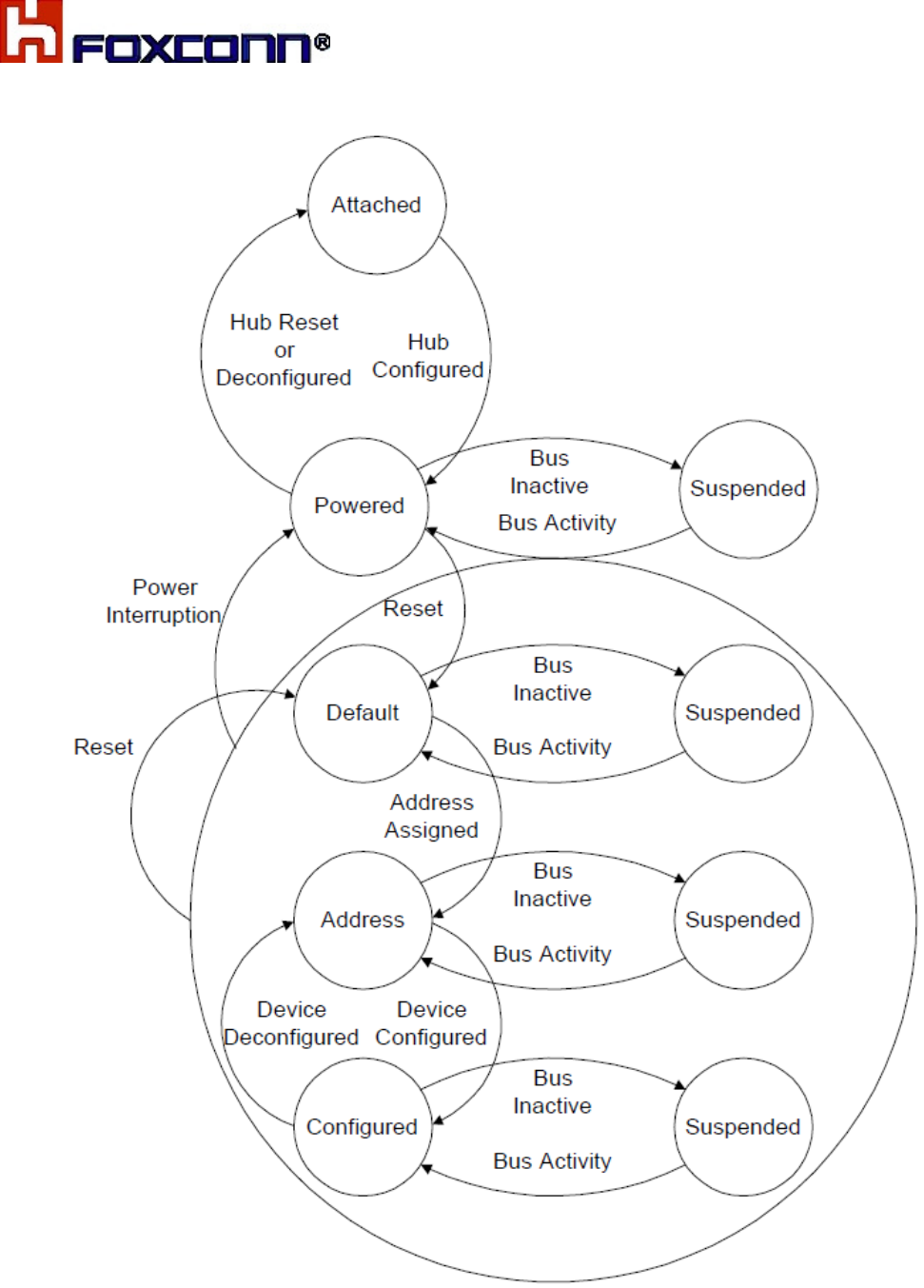
COMPANY CONFIDENTIAL
34
visible to the USB and the host, while others are internal to the USB device.
Figure 6-1. Device State Diagram

COMPANY CONFIDENTIAL
35
Table 6-1. Visible Device States
Attached
Powered
Default
Address
Configured
Suspended
State
No -- -- -- -- -- Device is not
attached to the
USB. Other
attributes are not
significant.
Yes No -- -- -- -- Device is attached
to the USB, but is
not powered. Other
attributes are not
significant.
Yes Yes No -- -- -- Device is attached
to the USB and
powered, but has
not been reset.
Yes Yes Yes No -- -- Device is attached
to the USB and
powered and has
been reset, but has
not been assigned
a unique address.
Device responds at
the default address.
Yes Yes Yes Yes No -- Device is attached
to the USB,
powered, has been
reset, and a unique
device address has
been assigned.
Device is not
configured.
Yes Yes Yes Yes Yes No Device is attached
to the USB,
powered, has been
reset, has a unique
address, is
configured, and is
not suspended. The
host may now use
the function
provided by the
device.
Yes Yes -- -- -- Yes Device is, at
minimum, attached
to the USB and is
powered and has
not seen bus

COMPANY CONFIDENTIAL
36
activity for 3 ms. It
may also have a
unique address and
be configured for
use. However,
because the device
is suspended, the
host may not use
the device's
function.
6.2 Windows Morphing
The device presents itself as different functions on different Windows OS. On windows 7, its
functions include Diag, RmNet, Modem, Application Interface and NEMA after the user
installs the driver package. On windows 8.1, its functions are MBIM and GPS after the user
installs the driver package. The devices that exhibit morphing behavior are referred to as
morphing devices. On Linux, its functions include Diag, ECM, Application Interface, Modem
and NMEA.
Windows morphing solution maps the morphing device’s USB configuration to a set of USB
functions. At any point in time, a single set of functions (by way of a configuration) are
exposed to the host. The solution achieves morphing by switching between these
configurations.
Logical configurations
The functions present in the device are grouped into the following logical sets.
Table 6-2. Logical Set of Functions
Logical Set of
Functions
Description
Windows-7-Configuration
Configuration selected by Windows 7 and older versions of
Windows when the morphing device is inserted into the host.
Linux-Configuration Configuration selected by Linux when the morphing device is
inserted into the host.
Windows-8-Configuration
Configuration selected by Windows 8 when the morphing device
is inserted into the host.
The following table shows the USB configurations listed in the previous table along with
possible interfaces and functions. Additional requirements for each configuration are
described in the remaining subtopics.
Table 6-2. Logical Set of Functions
Configuration 1
(Windows-7-Configuration)
Configuration 2
(Linux-Configuration)
Configuration 3
(Windows-8-Configuration)
Diag
RmNet
Modem
Application Interface
Diag
ECM
Application Interface
Modem
MBIM
GPS

COMPANY CONFIDENTIAL
37
NMEA NMEA
Goals of the solution
In Windows 7, host sends SET_CONFIGURATION request with value 1 to MDM9625
device. The functions defined in Configuration 1 will be exposed to the host.
In Linux, host sends SET_CONFIGURATION request with value 2 to MDM9625 device.
The functions defined in Configuration 2 will be exposed to the host
In Windows 8, host sends SET_CONFIGURATION request with value 3 to MDM9625
device. The functions defined in Configuration 3 will be exposed to the host.
Configuration requirements
The Windows-7-Configuration should be the first configuration in the morphing device.
Windows 8 and Linux will not select this configuration. In Windows 7 and earlier versions of
Windows, the Windows-7-Configuration is the default configuration selected.
The Windows-8-Configuration exposes the MBIM function as one of the functions on which
MBCD (Mobile Broadband Class Driver) is loaded. In Windows 8, the value of this
configuration is used in the subCompatibleID value returned to USBCCGP. USBCCGP
selects this configuration when it is loaded. The Windows-8-Configuration should be either
Configuration 2, 3, or 4. No other configuration is supported as the
Windows-8-Configuration.
Federal Communication Commission Interference Statement
This device complies with Part 15 of the FCC Rules. Operation is subject to the
following two conditions: (1) This device may not cause harmful interference, and (2)
this device must accept any interference received, including interference that may
cause undesired operation.
This equipment has been tested and found to comply with the limits for a Class B
digital device, pursuant to Part 15 of the FCC Rules. These limits are designed to
provide reasonable protection against harmful interference in a residential
installation. This equipment generates, uses and can radiate radio frequency energy
and, if not installed and used in accordance with the instructions, may cause
harmful interference to radio communications. However, there is no guarantee
that interference will not occur in a particular installation. If this equipment does
cause harmful interference to radio or television reception, which can be
determined by turning the equipment off and on, the user is encouraged to try to
correct the interference by one of the following measures:
- Reorient or relocate the receiving antenna.
- Increase the separation between the equipment and receiver.
- Connect the equipment into an outlet on a circuit different from that
to which the receiver is connected.
- Consult the dealer or an experienced radio/TV technician for help.
FCC Caution: Any changes or modifications not expressly approved by the party
responsible for compliance could void the user's authority to operate this
equipment.
This transmitter must not be co-located or operating in conjunction with any other
antenna or transmitter.

Radiation Exposure Statement:
The product comply with the FCC portable RF exposure limit set forth for an
uncontrolled environment and are safe for intended operation as described in this
manual. The further RF exposure reduction can be achieved if the product can be
kept as far as possible from the user body or set the device to lower output power if
such function is available.
This device is intended only for OEM integrators under the following conditions:
1. Antennas must be installed at least 2.5cm away from the user with no any metal
part surrounding the radiating elements to affect the SAR pattern. OEM manufacture
need to confirm SAR compliance if in doubt.
2. Only the identical antennas tested (including the excessive ground plane as shown
in the certification filing) must be sued for portable product. Other antenna(s) even
with the same antenna type and gain will need a class II permissive to verify the SAR
compliance.
3. No co-transmission with other transmitter.
As long as 3 conditions above are met, further transmitter test will not be required.
However, the OEM integrator is still responsible for testing their end-product for any
additional compliance requirements required with this module installed
IMPORTANT NOTE: In the event that these conditions can not be met (for example
certain laptop configurations or co-location with another transmitter), then the FCC
authorization is no longer considered valid and the FCC ID can not be used on the
final product. In these circumstances, the OEM integrator will be responsible for
re-evaluating the end product (including the transmitter) and obtaining a separate
FCC authorization.
End Product Labeling
The product can be kept as far as possible from the user body or set the device to
lower output power if such function is available. The final end product must be
labeled in a visible area with the following: “Contains FCC ID: MCLT77W595”. The
grantee's FCC ID can be used only when all FCC compliance requirements are met.
Manual Information To the End User
The OEM integrator has to be aware not to provide information to the end user
regarding how to install or remove this RF module in the user’s manual of the end
product which integrates this module.
The end user manual shall include all required regulatory information/warning as
show in this manual.
Industry Canada statement:
This device complies with RSS-210 of the Industry Canada Rules. Operation is subject
to the following two conditions: (1) This device may not cause harmful interference,
and (2) this device must accept any interference received, including interference
that may cause undesired operation.
Ce dispositif est conforme à la norme CNR-210 d'Industrie Canada applicable aux
appareils radio exempts de licence. Son fonctionnement est sujet aux deux
conditions suivantes: (1) le dispositif ne doit pas produire de brouillage préjudiciable,
et (2) ce dispositif doit accepter tout brouillage reçu, y compris un brouillage
susceptible de provoquer un fonctionnement indésirable.
Radiation Exposure Statement:
The product comply with the Canada portable RF exposure limit set forth for an
uncontrolled environment and are safe for intended operation as described in this
manual. The further RF exposure reduction can be achieved if the product can be
kept as far as possible from the user body or set the device to lower output power if
such function is available.
Déclaration d'exposition aux radiations:
Le produit est conforme aux limites d'exposition pour les appareils portables RF pour
les Etats-Unis et le Canada établies pour un environnement non contrôlé.
Le produit est sûr pour un fonctionnement tel que décrit dans ce manuel. La
réduction aux expositions RF peut être augmentée si l'appareil peut être conservé
aussi loin que possible du corps de l'utilisateur ou que le dispositif est réglé sur la
puissance de sortie la plus faible si une telle fonction est disponible.
This device is intended only for OEM integrators under the following conditions:
1. Antennas must be installed at least 2.5cm away from the user with no any metal
part surrounding the radiating elements to affect the SAR pattern. OEM manufacture
need to confirm SAR compliance if in doubt.
2. Only the identical antennas tested (including the excessive ground plane as shown

in the certification filing) must be sued for portable product. Other antenna(s) even
with the same antenna type and gain will need a class II permissive to verify the SAR
compliance.
3. No co-transmission with other transmitter.
As long as 3 conditions above are met, further transmitter test will not be required.
However, the OEM integrator is still responsible for testing their end-product for any
additional compliance requirements required with this module installed
Cet appareil est conçu uniquement pour les intégrateurs OEM dans les conditions
suivantes:
1. Une. Les antennes doivent etre installes a au moins 2,5 cm loin de l'utilisateur,
sans aucune partie metallique entourant les elements rayonnants a affecter le
modele SAR. Fabrication OEM besoin pour confirmer la conformite SAR en cas de
doute.
2. Seules les antennes identiques testes (y compris le plan excessive du sol, comme
indique dans le depot de certification) doivent etre poursuivis pour produit portable.
Autre antenne (s) meme avec le meme type et le gain d'antenne aura besoin d'un
permissive classe II de verifier la conformite SAR.
3. Aucune co-transmission avec un autre emetteur.
Tant que les 3 conditions ci-dessus sont remplies, des essais supplémentaires sur
l'émetteur ne seront pas nécessaires. Toutefois, l'intégrateur OEM est toujours
responsable des essais sur son produit final pour toutes exigences de conformité
supplémentaires requis pour ce module installé.
IMPORTANT NOTE:
In the event that these conditions can not be met (for example certain laptop
configurations or co-location with another transmitter), then the Canada
authorization is no longer considered valid and the IC ID can not be used on the final
product. In these circumstances, the OEM integrator will be responsible for
re-evaluating the end product (including the transmitter) and obtaining a separate
Canada authorization.
NOTE IMPORTANTE:
Dans le cas où ces conditions ne peuvent être satisfaites (par exemple pour certaines
configurations d'ordinateur portable ou de certaines co-localisation avec un autre
émetteur), l'autorisation du Canada n'est plus considéré comme valide et l'ID IC ne
peut pas être utilisé sur le produit final. Dans ces circonstances, l'intégrateur OEM

sera chargé de réévaluer le produit final (y compris l'émetteur) et l'obtention d'une
autorisation distincte au Canada.
End Product Labeling
The product can be kept as far as possible from the user body or set the device to
lower output power if such function is available. The final end product must be
labeled in a visible area with the following: “Contains IC: 2878D-T77W595”.
Plaque signalétique du produit final
L'appareil peut être conservé aussi loin que possible du corps de l'utilisateur ou que
le dispositif est réglé sur la puissance de sortie la plus faible si une telle fonction est
disponible. Le produit final doit être étiqueté dans un endroit visible avec
l'inscription suivante: "Contient des IC: 2878D-T77W595".
Manual Information To the End User
The OEM integrator has to be aware not to provide information to the end user
regarding how to install or remove this RF module in the user’s manual of the end
product which integrates this module.
The end user manual shall include all required regulatory information/warning as
show in this manual.
Manuel d'information à l'utilisateur final
L'intégrateur OEM doit être conscient de ne pas fournir des informations à
l'utilisateur final quant à la façon d'installer ou de supprimer ce module RF dans le
manuel de l'utilisateur du produit final qui intègre ce module.
Le manuel de l'utilisateur final doit inclure toutes les informations réglementaires
requises et avertissements comme indiqué dans ce manuel.
DETACHABLE ANTENNA USAGE
This device has been designed to operate with a PIFA antenna have a maximum gain
of [6.14] dBi. Antenna having a higher gain is strictly prohibited per regulations of
Industry Canada. The required antenna impedance is 50 ohms.
Under Industry Canada regulations, this radio transmitter may only operate using an
antenna of a type and maximum (or lesser) gain approved for the transmitter by
Industry Canada. To reduce potential radio interference to other users, the antenna
type and its gain should be so chosen that the equivalent isotropically radiated
power (e.i.r.p.) is not more than that necessary for successful communication.
This radio transmitter (IC: 2878D-T77W595/ Model: T77W595) has been approved by
Industry Canada to operate with the antenna type, maximum permissible gain and
required antenna impedance for each antenna type indicated. Antenna types not
included in this user's manual, having a gain greater than the maximum gain
indicated for that type, are strictly prohibited for use with this device.
Ce dispositif a été conçu pour fonctionner avec une antenne ayant un gain maximal
de PIFA antenne avec dBi [6.33]. Une antenne à gain plus élevé est strictement
interdite par les règlements d'Industrie Canada. L'impédance d'antenne requise est
de 50 ohms.
Conformément à la réglementation d'Industrie Canada, le présent émetteur radio
peutfonctionner avec une antenne d'un type et d'un gain maximal (ou inférieur)
approuvé pourl'émetteur par Industrie Canada. Dans le but de réduire les risques de
brouillage radioélectriqueà l'intention des autres utilisateurs, il faut choisir le type
d'antenne et son gain de sorte que lapuissance isotrope rayonnée équivalente
(p.i.r.e.) ne dépasse pas l'intensité nécessaire àl'établissement d'une communication
satisfaisante.
Le présent émetteur radio (IC: 2878D-T77W595/ Modèle: T77W595) a été approuvé
par Industrie Canada pour fonctionner avec les types d'antenne énumérés ci-dessous
et ayant un gain admissible maximal et l'impédance requise pour chaque type
d'antenne. Les types d'antenne non inclus dans cette liste, ou dont le gain est
supérieur au gain maximal indiqué, sont strictement interdits pour l'exploitation de
l'émetteur.